March 15th through 19th, 2022
Fredericksburg, Texas is 864 miles southeast of Denver, and 78 miles west of Austin. It is the traditional home of Texas Hell Week, a seven-day cycling event offering a choice of a 30, a 60, and a 100 mile ride each day, usually held the end of March. After a successful cycling week in South Dakota in October JoAnna thought it would be fun to see what these much-talked-about routes in the Hill Country of Texas were all about, so she organized a trip for the week before the official Hell Week. Using an app called Ride with GPS, it was possible to browse through dozens and dozens of routes other cyclists had documented and described with turn by turn riding instructions. Five of us arrived in Fredericksburg on March 14th to begin our adventure the next day.
We stayed in a quaint motel called the Country Inn and Cottages, which had no luxury features to speak of and little room to maneuver within the rooms, but the noise from the busy highway was not too bad after 11 pm and before 5:30 am. It was clean, the staff was friendly, and it served as a great starting point for three of the four rides we did together.
March 15th – Muesbach-Luckenbach Loop
Our first ride was not quite 42 miles and was made up of a loop we found on the cycle app we were all using. Some of us remembered the Waylon Jennings song from 1977, and were curious to see the town. The description of the ride indicated that it avoided traffic and busy roads.
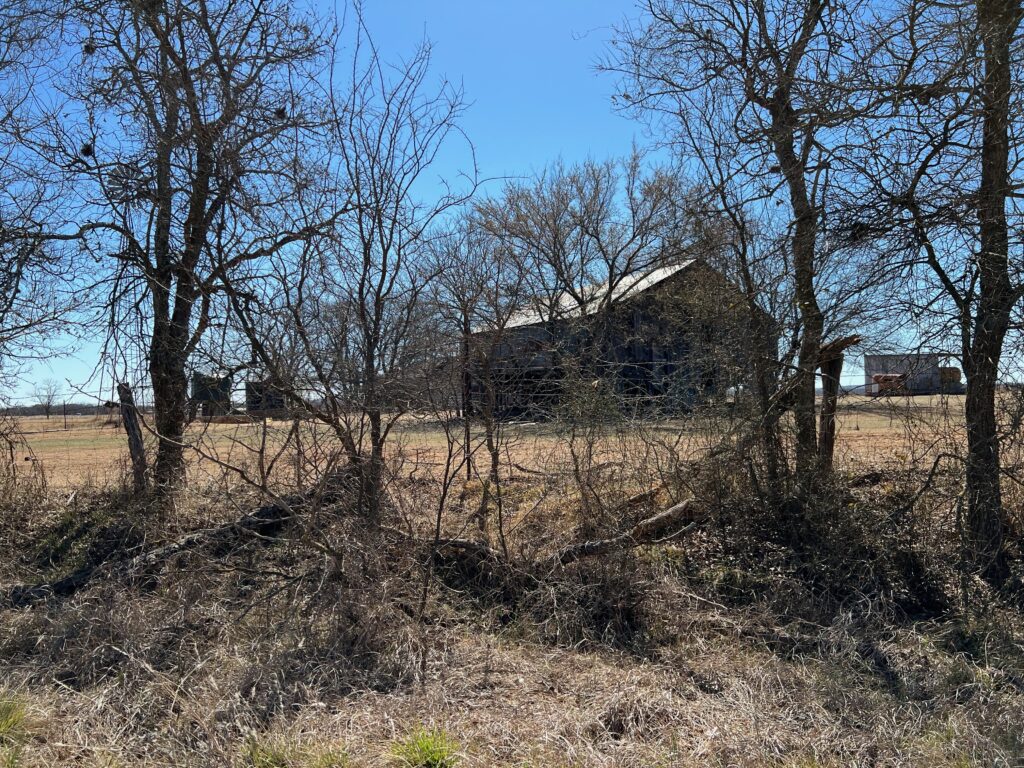
As we pedaled through ranch land on quiet back roads we were struck by the contrast of wealthy ranch mansions, set back behind long dirt lanes guarded by high arching pillars and wrought iron gates, not far down the road from collapsing barns, rusted tractors, old pickup trucks up on blocks, and other signs of a failing economy.
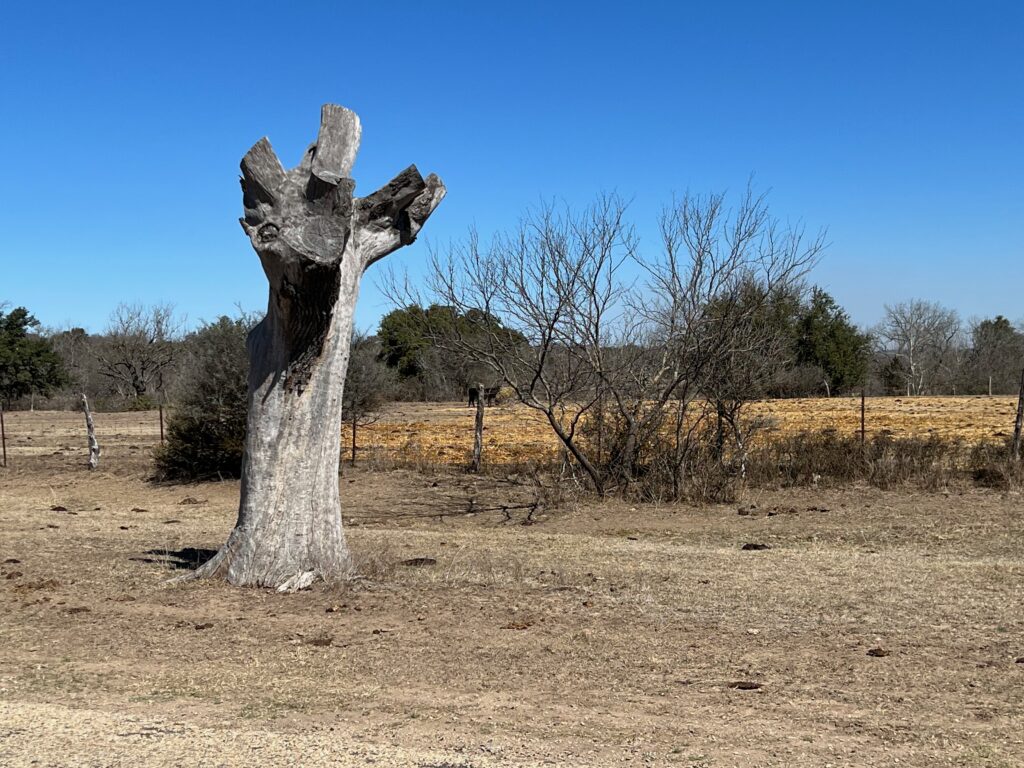
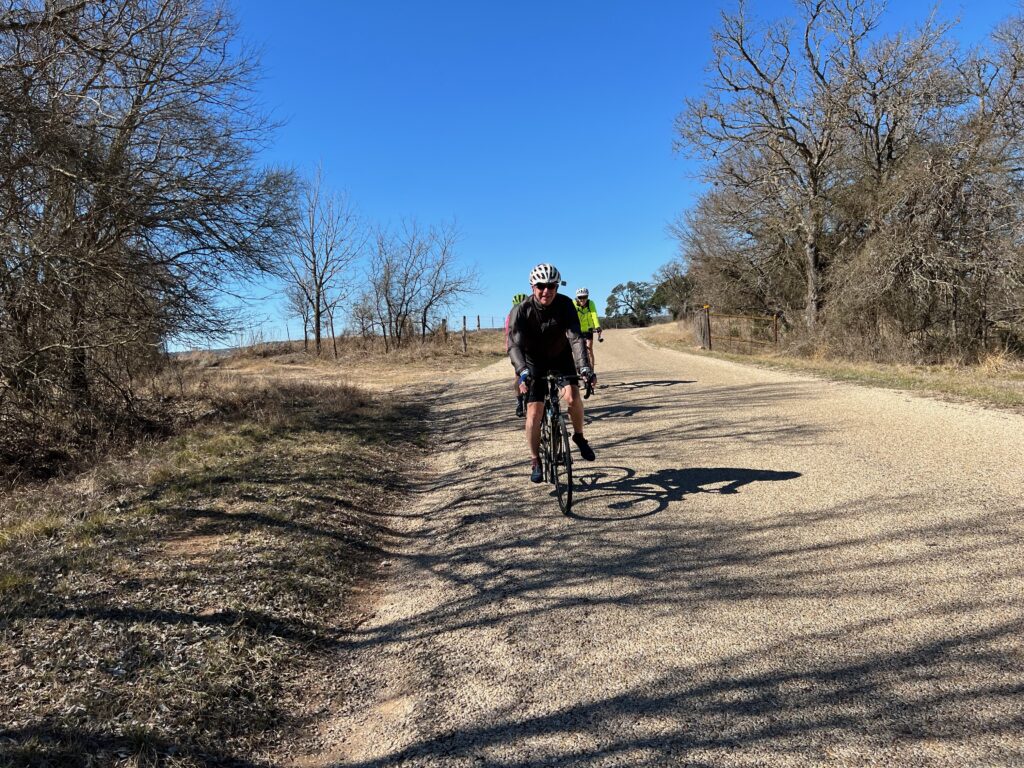
In Colorado we’re used to riding on chip ‘n seal, a type of paving where crushed rock is laid on old dirt or decayed highway, and sealed with hot tar. It is usually rough and offers a high degree of rolling resistance, since the crushed rock is course and bumpy. The back roads we were on in Gillespie County were mostly chip ‘n seal, but the rocks were round and smooth, as if they had been mined from a river or stream bed. This made for a smooth ride whenever we were going downhill with a tailwind.
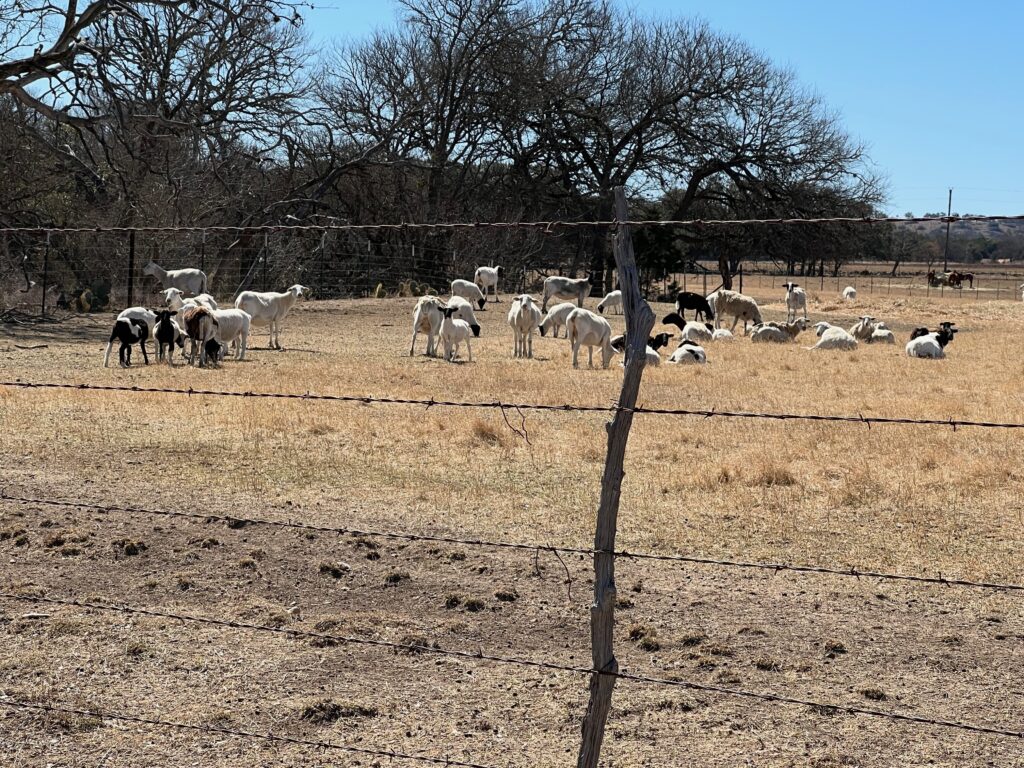
We saw lots of livestock as we casually rode through the countryside. This photo is of sheep that had been recently shorn. The most prevalent animals we saw were Black Angus cattle, raised for beef. We also saw goats, Hereford beef cattle, a few Longhorns, and what appeared to be domesticated exotic antelopes or gazelles.
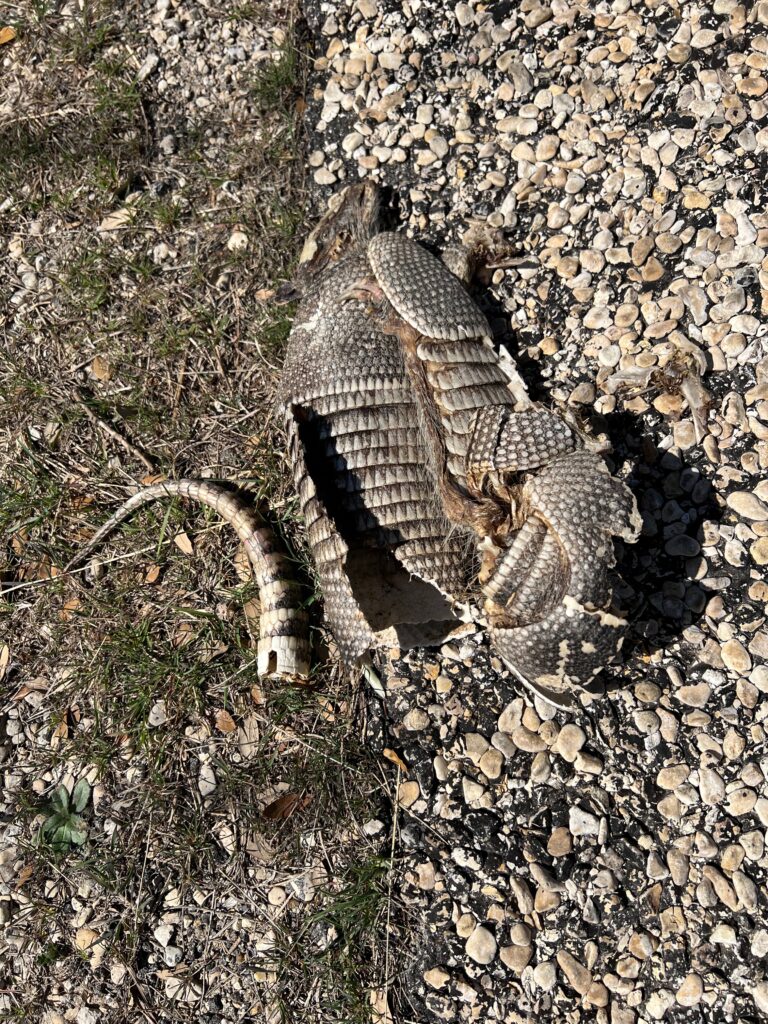
White-tail deer are common in the Hill Country of Texas. So are speeding pickup trucks driven by young men drinking Lone Star beer at dusk on back country roads. We saw dozens of deer carcasses along the road every day. I chose not to photograph any, but I had to take a picture of this dead armadillo, since I couldn’t remember ever seeing one before. In addition to deer carcasses, black vultures filled the sky everywhere we went. We were also treated several times to living deer crossing our paths as we rode. Sadly, we heard talk of chronic wasting disease infecting the deer population, but others said it only affected mule deer in Texas so far, which live mostly in other parts of the state. We only saw white-tail deer on our rides. We also heard that deer are subject to COVID-19 infections.
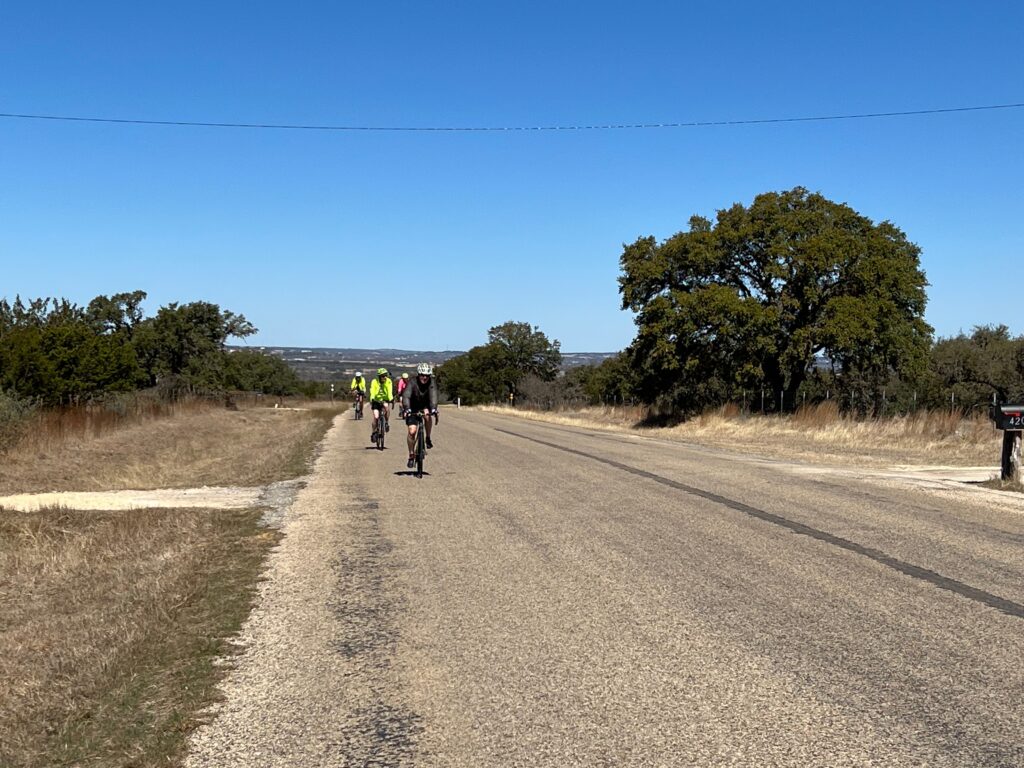
We didn’t have a lot of flat terrain. Although there weren’t climbs of thousands of feet like we have in Colorado, we had to come up some pretty steep grades, often into a strong headwind. Three of our four days of riding gave us relentless winds of twenty miles an hour or stronger, always out of the direction we had to ride to get back to town. The effort required on these climbs was offset by some beautiful descents down to stream crossings and wooded groves.
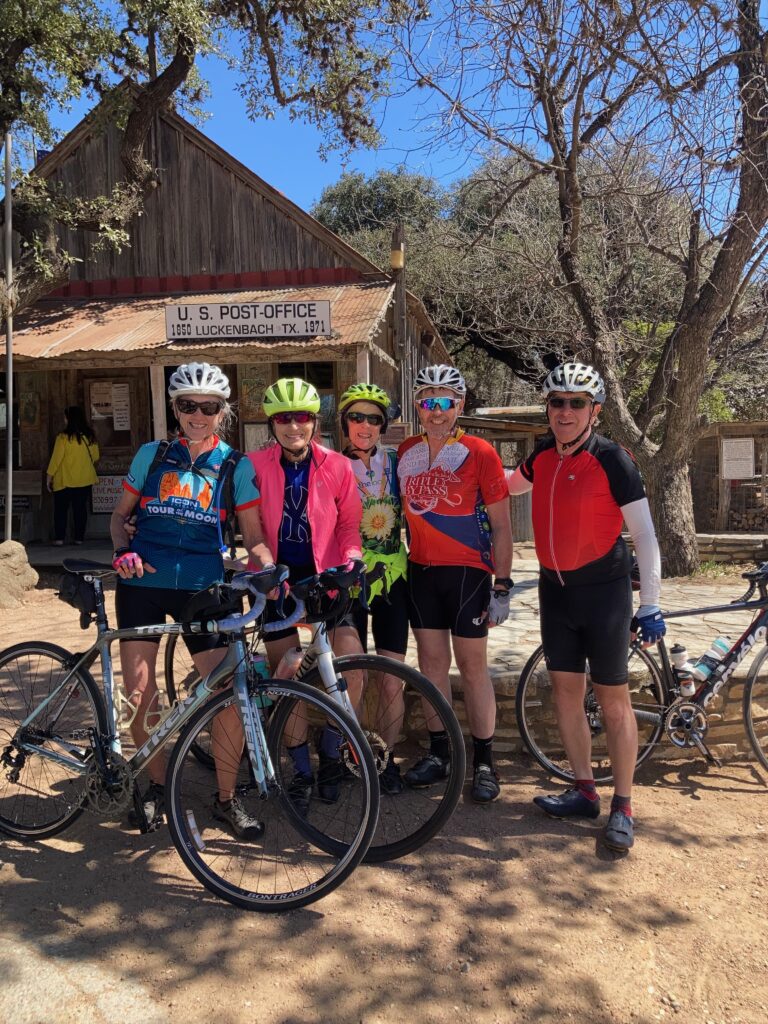
I don’t know the history of Luckenbach, Texas, other than that Waylon Jennings sang a very popular country song about it in 1977. When we got there we were about halfway through our first day’s ride, and we found a dirt parking lot, some funky wooden buildings that might have been moved there from somewhere else or might have been all that was left of what was once a little town. There were lots of tourists taking pictures, and a small stage where I assume they held concerts and maybe put on old western dramas. We were (or at least I was) happy to find a functioning bathroom. As you’ll see in the next picture, there was a permanent school building a little further up the road.
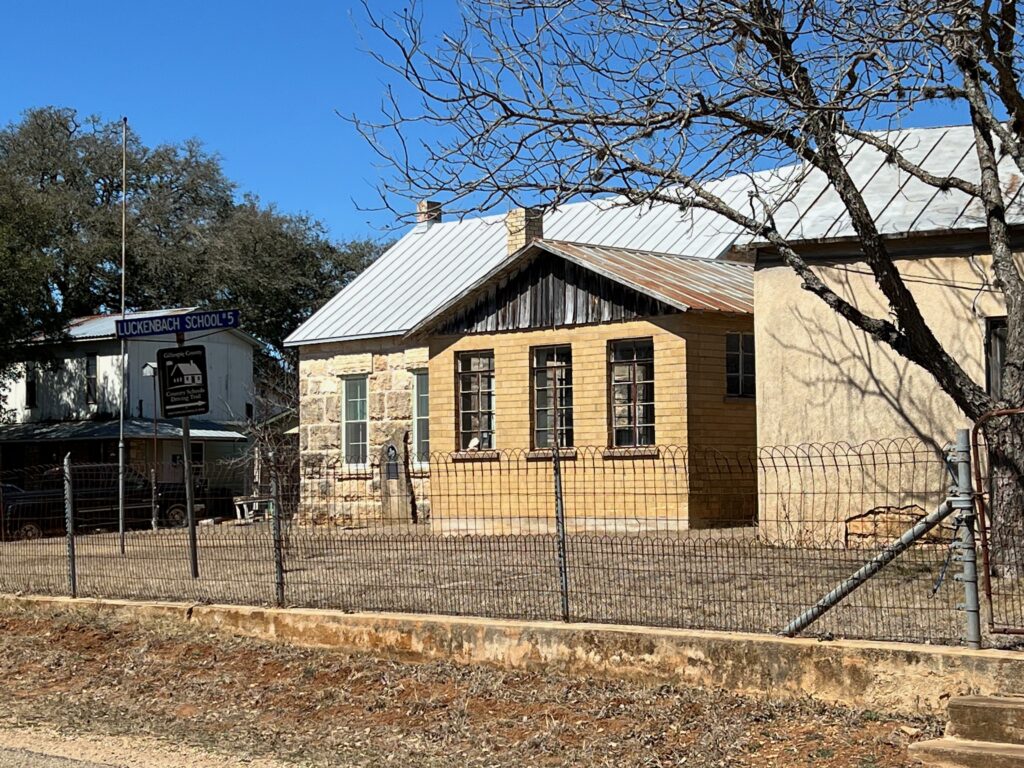
March 16th – Enchanted Rock Long Course
We had heard about the Enchanted Rock State Natural Area, and found a ride on our app that took us there on a big loop with a spur off of the loop to get to the park. We had hoped to rest there, as it was not quite at the half way point of our ride, but it wasn’t set up to accommodate cyclists looking to picnic in the shade. It also turned out we had been descending for the second quarter of our ride with a tail wind, which was made apparent when we started our trip back.
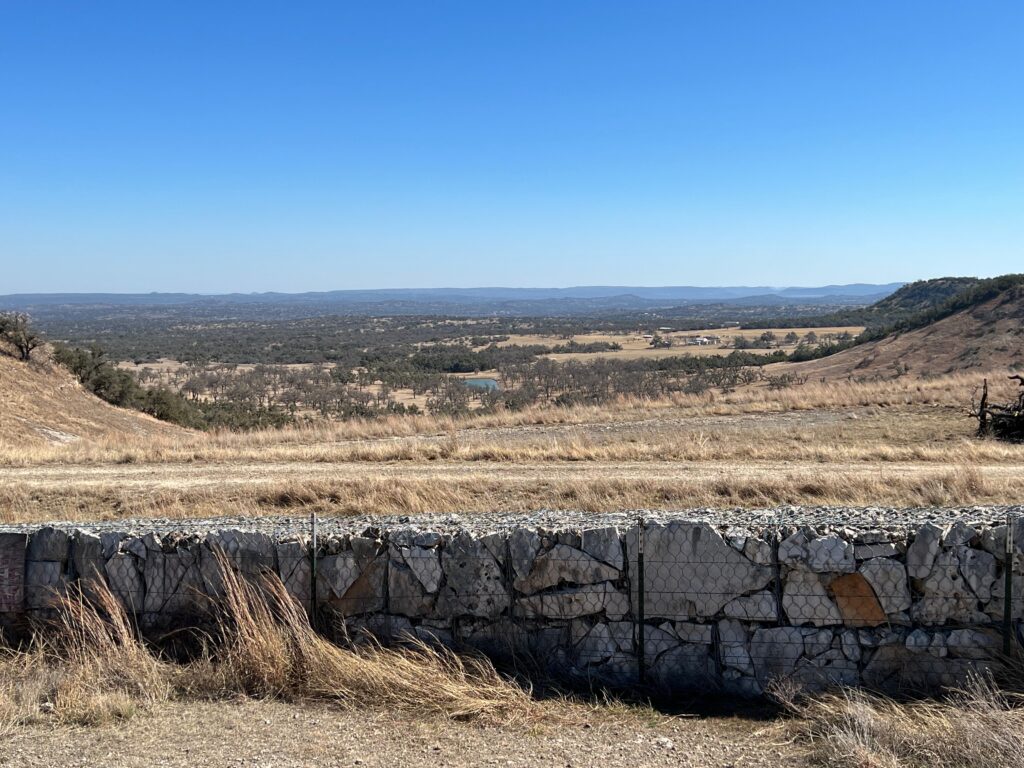
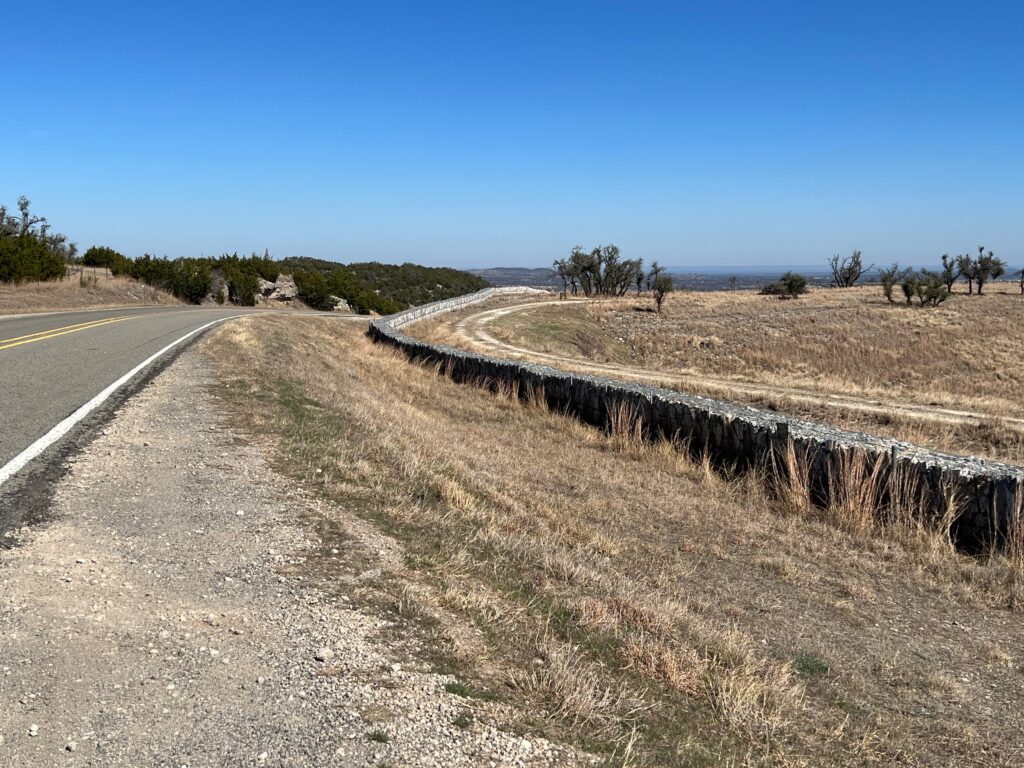
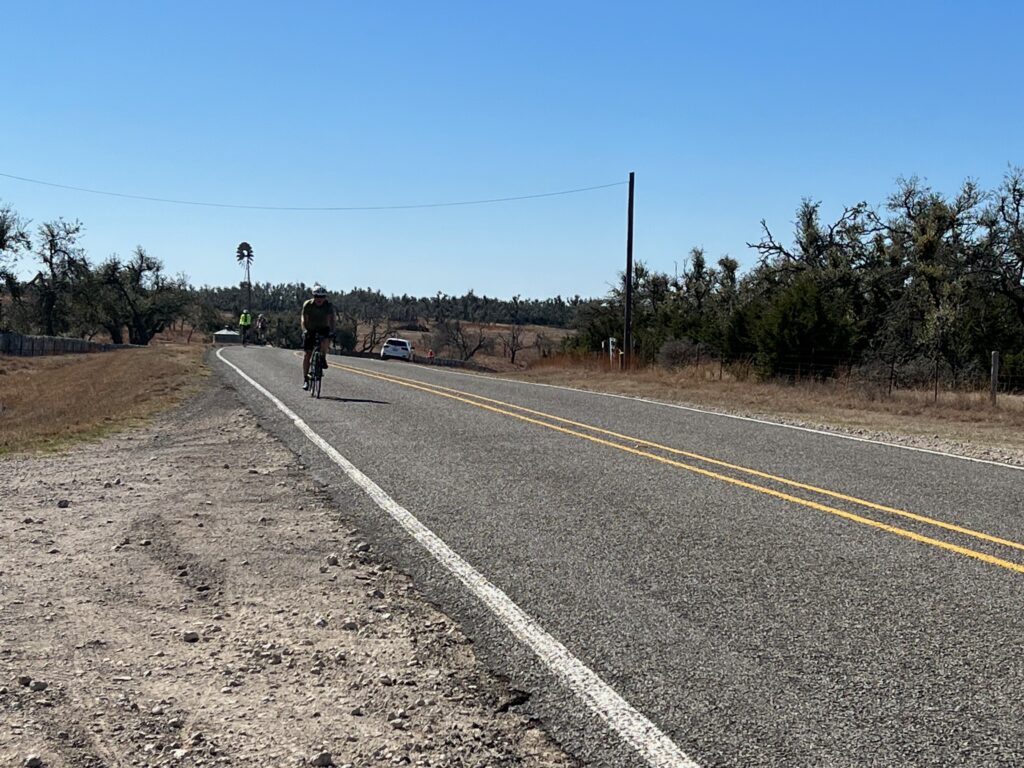
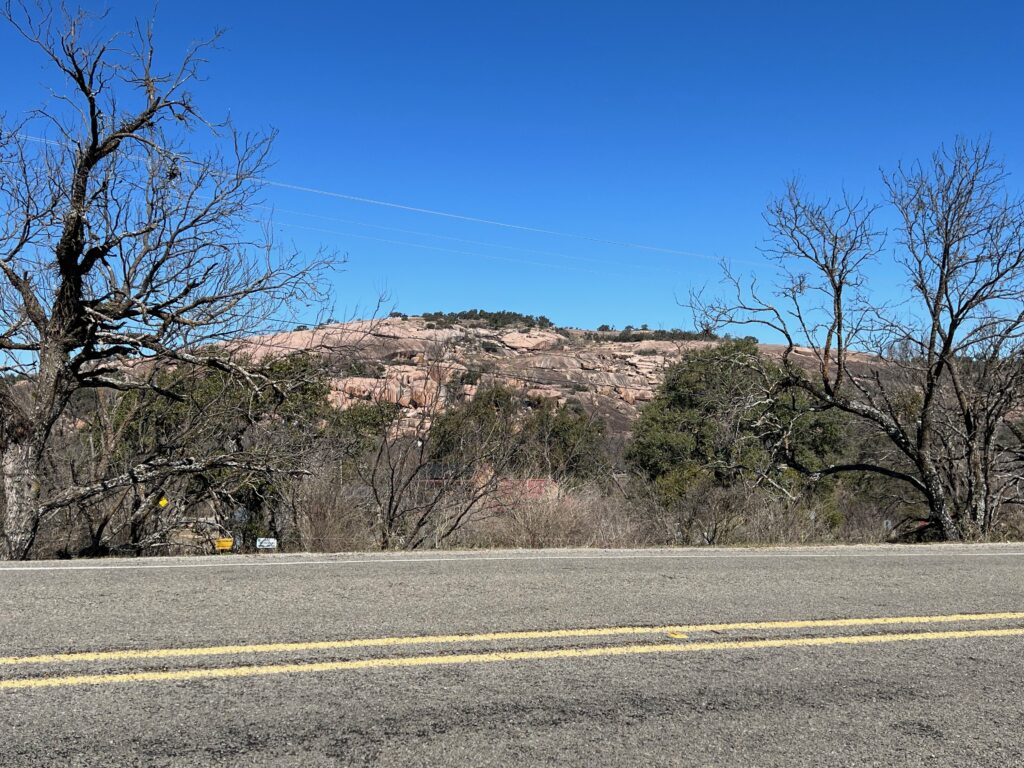
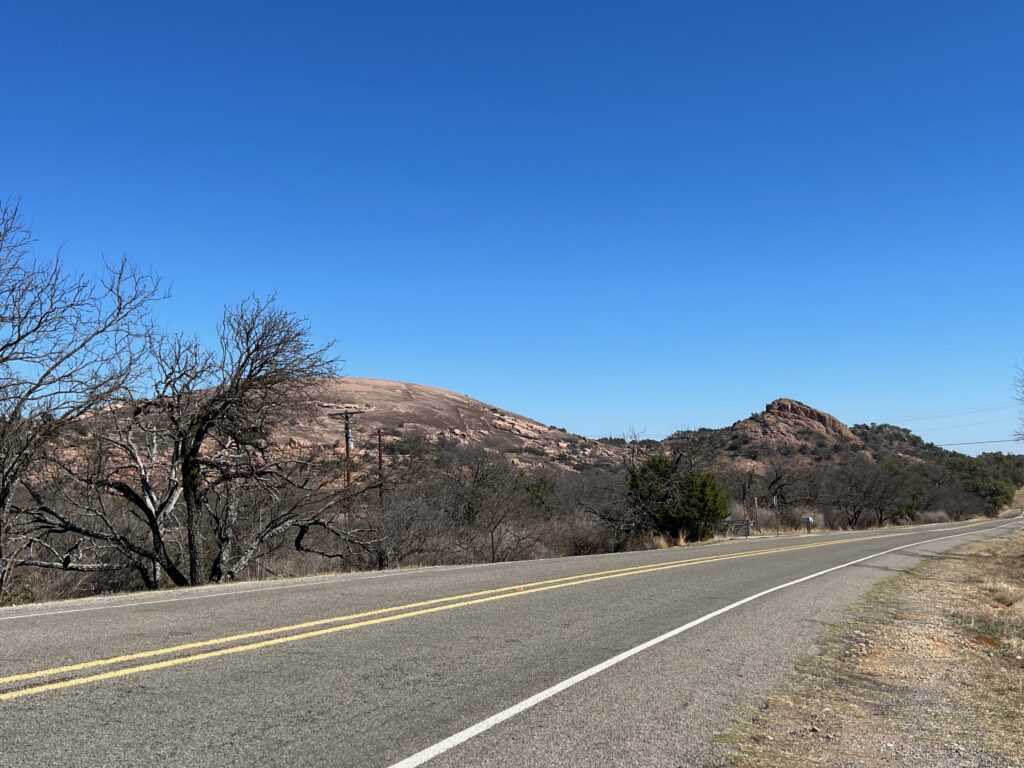
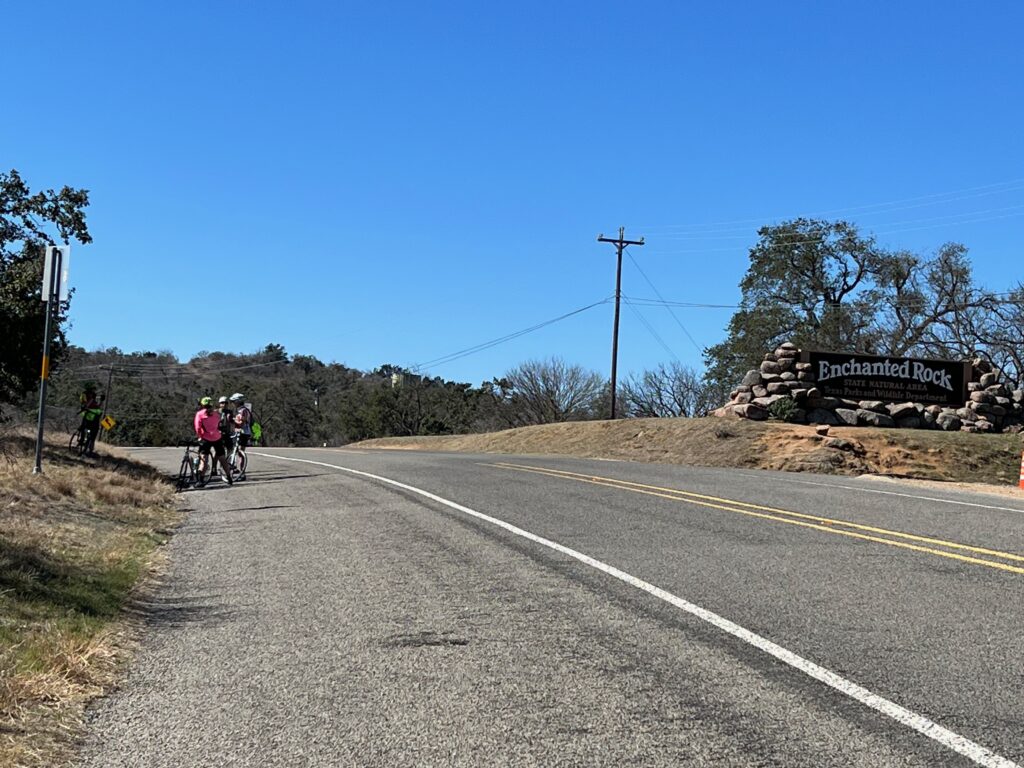
When we planned our second day’s ride and saw the spur to the park, I assumed the spur was a road that led to and ended at the park. I thought the only drivers would be park visitors, and that the speed limit would be 25 miles an hour, as I was used to at state parks in Colorado. This turned out to be one of the busiest highways we rode on, and except for a few hundred yards near the park entrance, had no shoulder. Because we faced a long, steep climb leaving the park entrance, we spent a lot of time climbing slowly with cars whizzing past us. We had no incidents and it was a safe ride, but compared to the tranquility of the quiet farm roads we had been on, and would be on again once we got off the spur, it was a bit more tense. I rode much harder than I would have otherwise and ran out of water, cause my hamstrings to cramp up later that evening.
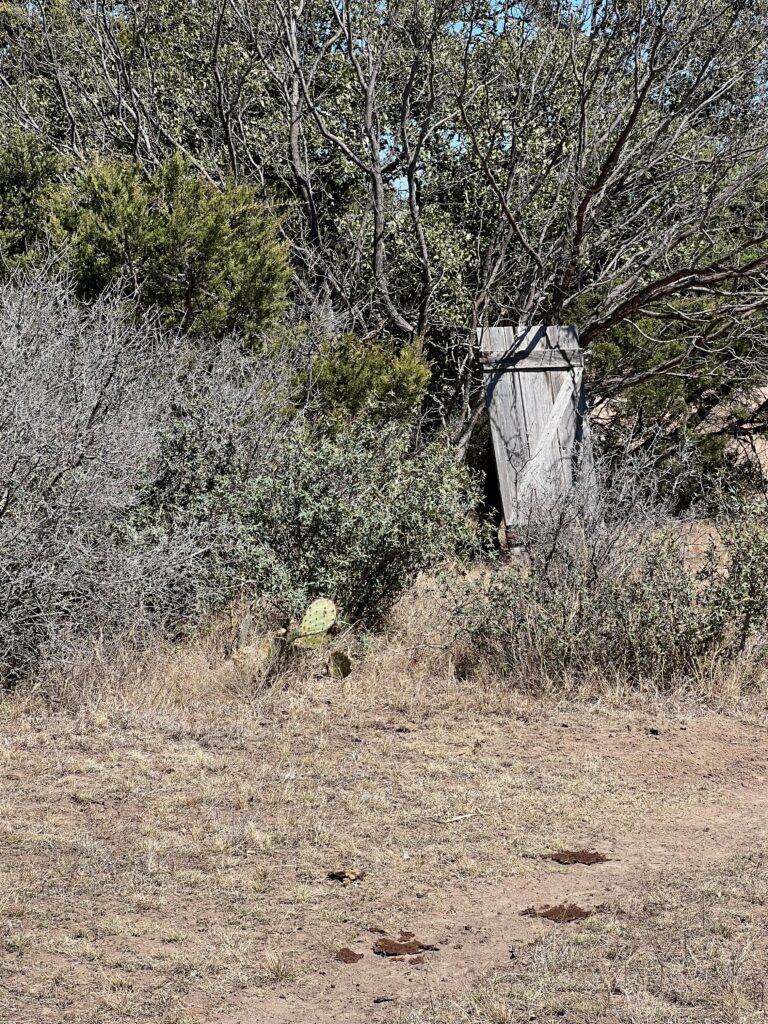
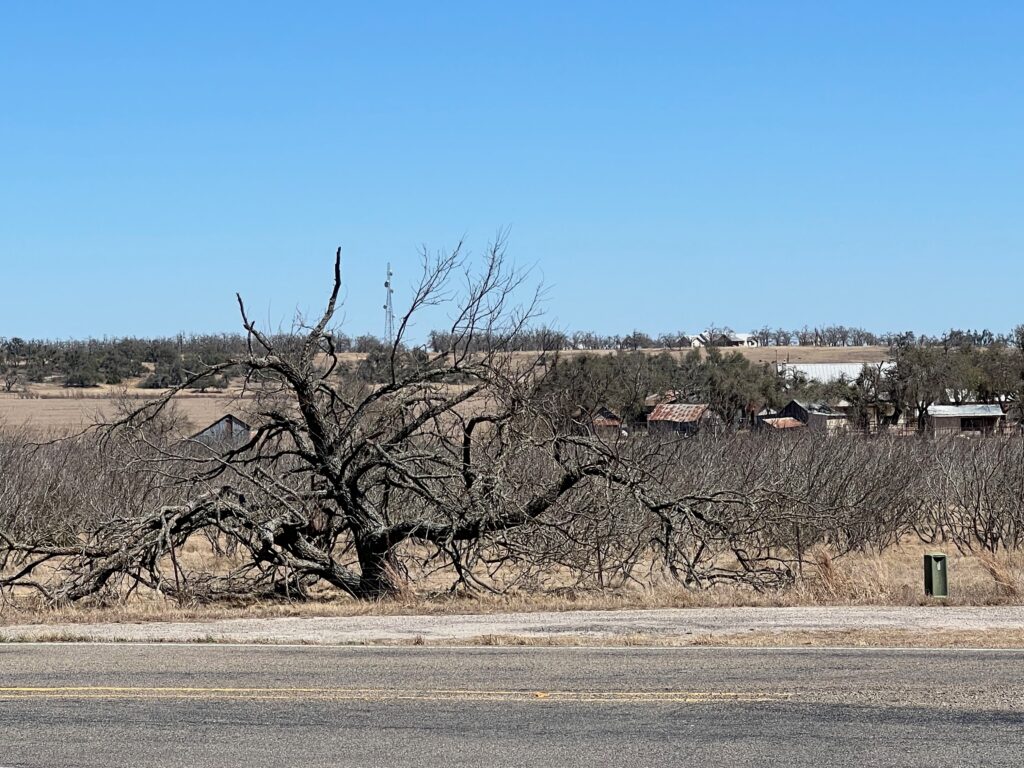
On top of this hill you can see what looks like a large estate. There were really nice properties scattered here and there that we saw on our rides. I wondered if these estates were from old money made during the days of the oil boom, or the days when cattle ranching was highly lucrative, or perhaps these belonged to people who made their money elsewhere and built homes when they retired here. Closer to the foreground are run-down structures with rusted corrugated tin roofs, presumably the ruins of once-thriving farm or ranch buildings that don’t seem to be in operation any more. In the immediate foreground stands a dead live oak tree. I asked a ranger at the Enchanted Rock park about the apparent blight on the oak trees and she attributed it to a severe freeze from the previous winter. In my further reading I found out a little more.
The Hill Country, up until the past year or so, was fairly lush year round, due to the nature of the live oak trees. Live oak trees keep their green leaves throughout the winter, and only shed them when the new green leaves in the spring force the old leaves to fall. An exception is when there is a prolonged deep freeze, when the older leaves will turn brown and be shed before the new leaves come out. This apparently happened in the winter of 2021. But all the healthy trees leafed out again in the spring. A bigger problem with the Texas live oak trees is Texas Oak Wilt, which is killing whole stands of trees. It appears this is what is responsible for the blighted landscape we saw across much of the land through which we rode. The disease spreads especially fast through stands of live oak trees because their root systems become connected underground, allowing the bacteria, or fungus, or virus, or whatever causes the wilt, to spread easily from tree to tree.
In my mind the wilt is tragic. As a graduate student in Arizona I used to camp in an area east of Tucson populated with large, healthy live oak trees. They are a unique tree with a distinct character, and they grow in places that are otherwise dry and barren. If whole populations of these trees are killed I fear this area will become completely desertified.
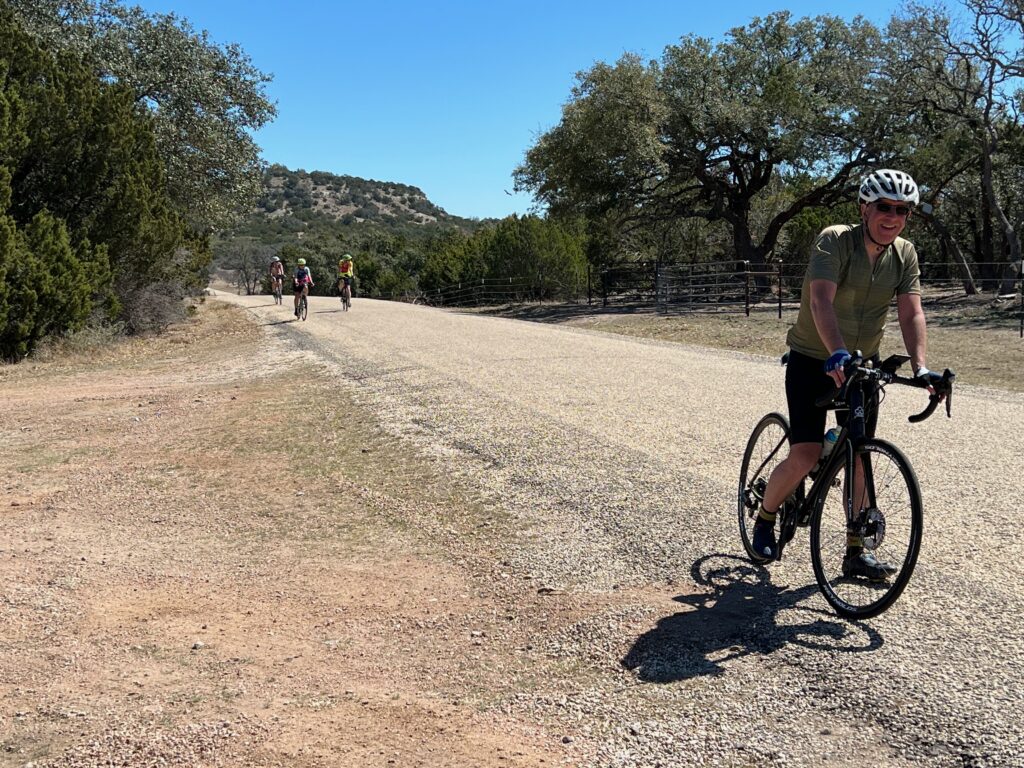
In contrast to the busy, steep climb on the spur leading back from the Enchanted Rock Natural Area, and unlike the dead stands of live oak trees, we spent a lot of time riding on quiet, tree-lined country roads that were perfect for recreational cyclists. You can see Howard smiling here. I promise that his smile was matched by smiles from Allison, Barbara, and JoAnna, although JoAnna might have been a little concerned that her Wahoo cycling computer was not registering the same altitude accumulation as everyone else.
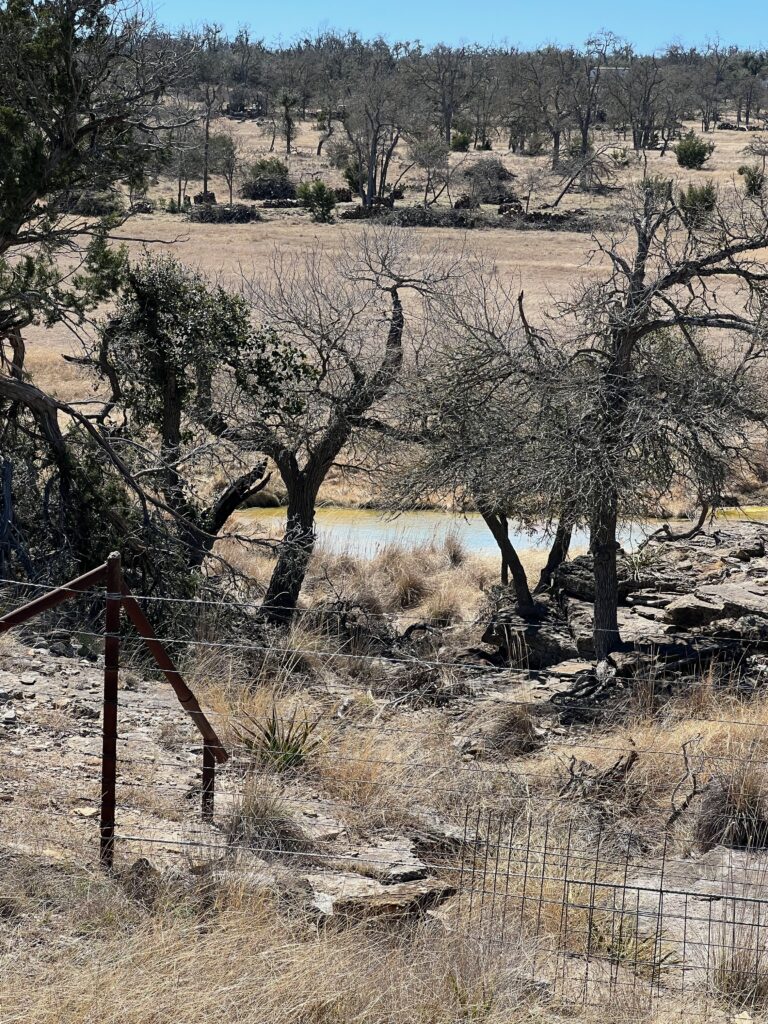
We could not take the greenery for granted. As we rounded a corner or reached a change in the grade of the road, the complexion of the landscape changed. Looking across this stream to what I assume was once a thick green stand of live oak trees, I only saw dead wood. I wish I could have talked to more lifelong residents of the area to get a sense of the changing landscape.
The Rusted Tractor
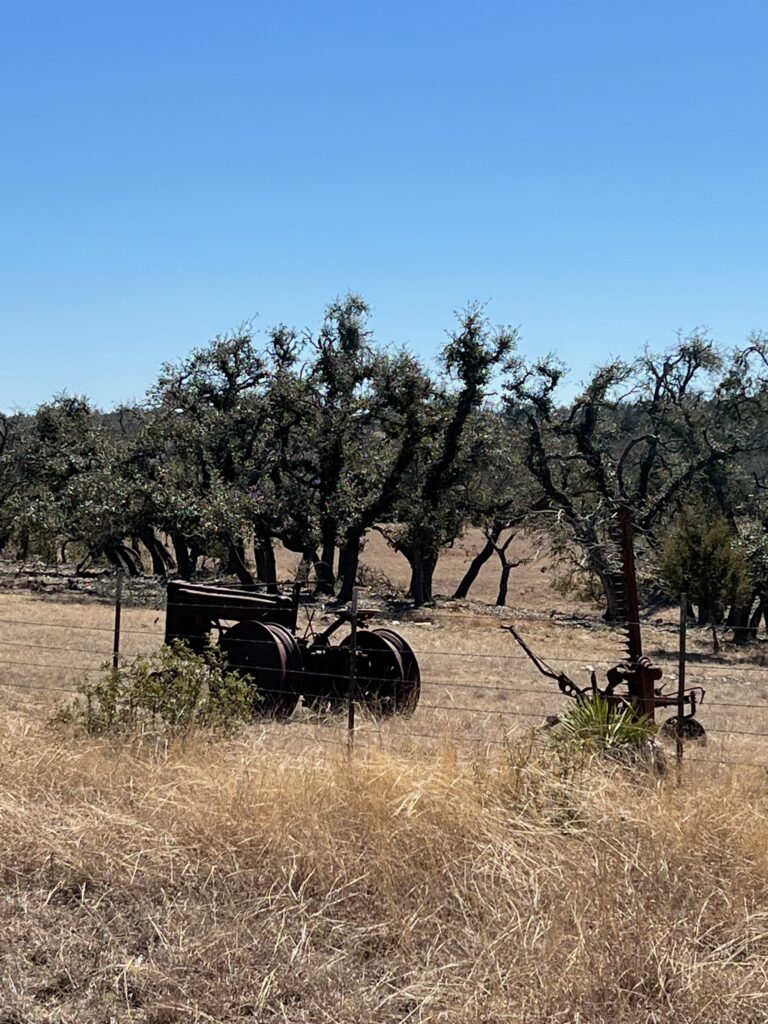


So much depended upon
that now rusted tractor
immobile and pinned down by weeds
by the wilted oaks
With apologies to William Carlos Williams, I was struck by how much of what we saw riding through the Hill Country of central Texas is a metaphor for the United States.
March 17th – The Lyndon Baines Johnson National Historical Park, Stonewall, Texas
With the wind and the unexpected climbing the day before, we were all ready for an easy day of riding on Wednesday. Serious cyclists call these recovery rides, when, after a really hard couple of days of training, they ride fewer miles at a slower pace with less climbing to give their heart, lungs, and legs a chance to relax, but still get in some exercise. Recreational cyclists like us call easy days like these recovery rides too, because, face it, we ride expensive carbon fiber frames with top-of-the-line drive trains, outfit ourselves in kits like those that the pros from Spain, England, France, Germany, Belgium, Italy, Colombia, and Slovakia wear, talk endlessly about the teeth on our chain rings and cassettes, have calculate our maximum and resting heart rates and share our wattage output on our neighborhood climbs, and ride at a pace of maybe 8 to 10% of those guys in the Tour de France. So, yeah, we need recovery rides, too.
Besides, we knew we were close to the Lyndon Baines Johnson National Historical Park, had wanted to see it anyway, and knew we could ride our bikes through it. We had a delightful day celebrating the fact that we were Colorado liberals in conservative Texas, satisfying our tourist cravings, getting a minimum of bicycling in, and resting our quads, hamstrings, and glutes after a hard day the day before.
We all talked about the paradox of LBJ as we rode around the property where he was born, raised, and established his Texas White House: the understanding we had that Kennedy selected him as a running mate primarily to attract Southern Democrats; the irony that he was probably a racist who enacted such significant civil rights legislation; the horrors of the Vietnam War that escalated under his administration and caused such a rift in our country; his decision to not run in 1968. I think I was the only one who remembers that he had two beagles that he lifted up by the ears in front of reported to make the dogs howl – howls that were caused by the pain of being lifted up by the ears, but that Johnson thought was amusing – and was confused by the outrage it caused.
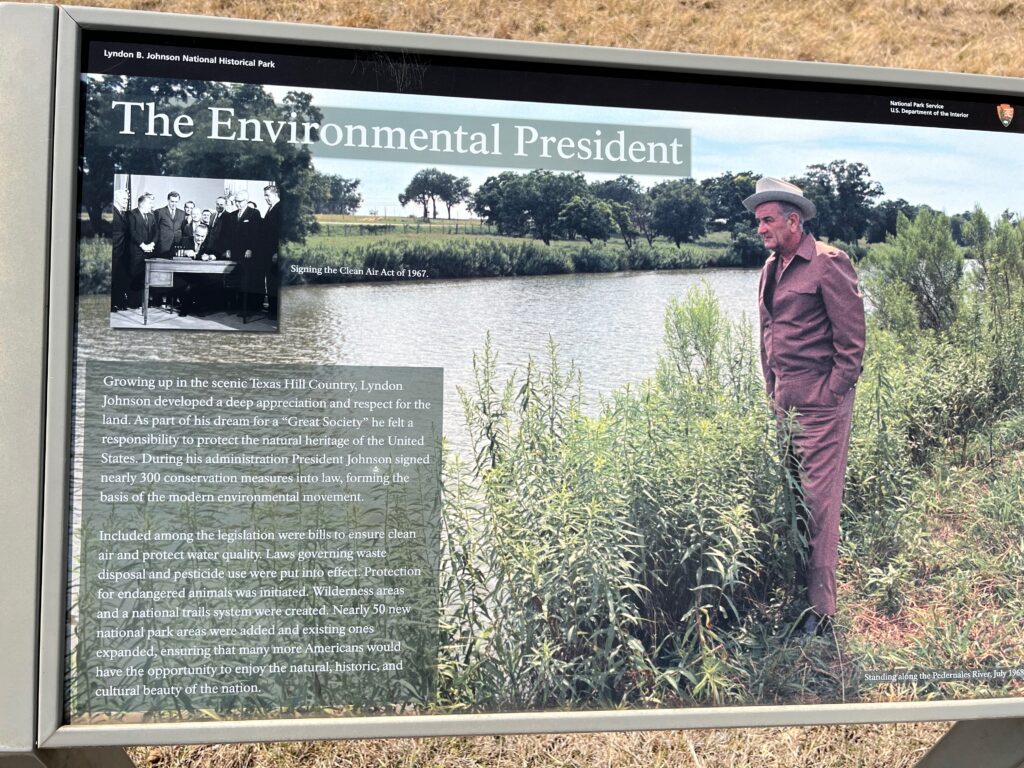
I would like to believe that much of what the plaque pictured above says is true. I know that there was a lot of backlash and undoing of what Johnson, Carter, and even Nixon had done to protect the environment when Reagan took office. Does Johnson not get enough credit for his environmental activism? Is it overshadowed by the disaster of the Vietnam War?
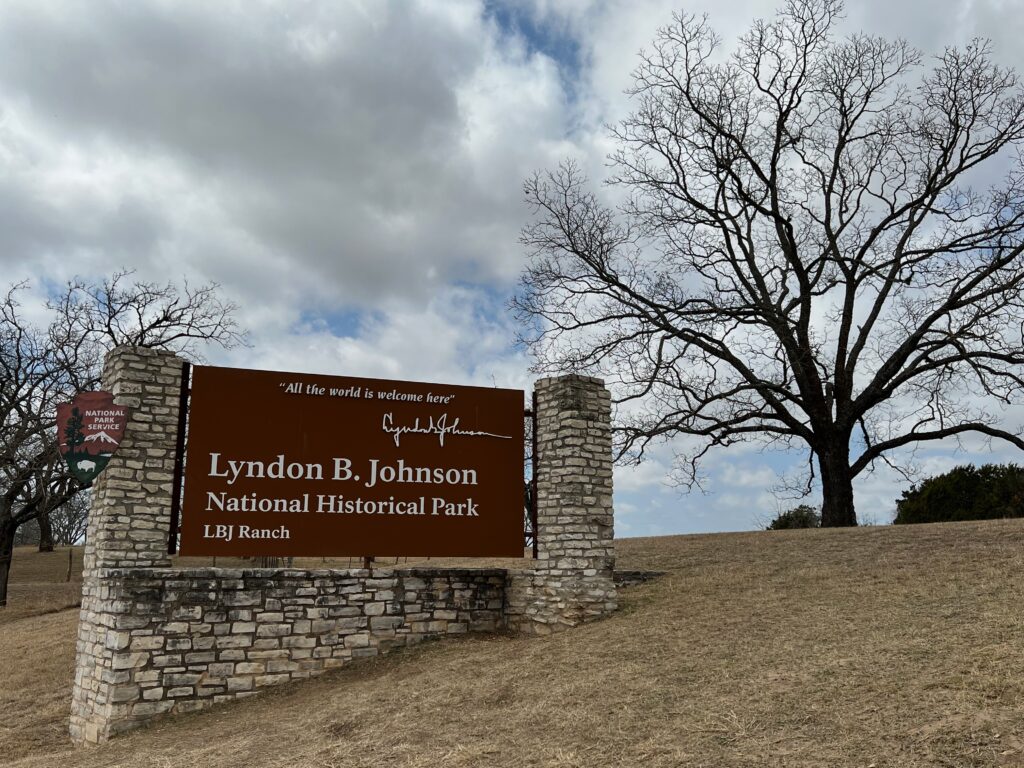
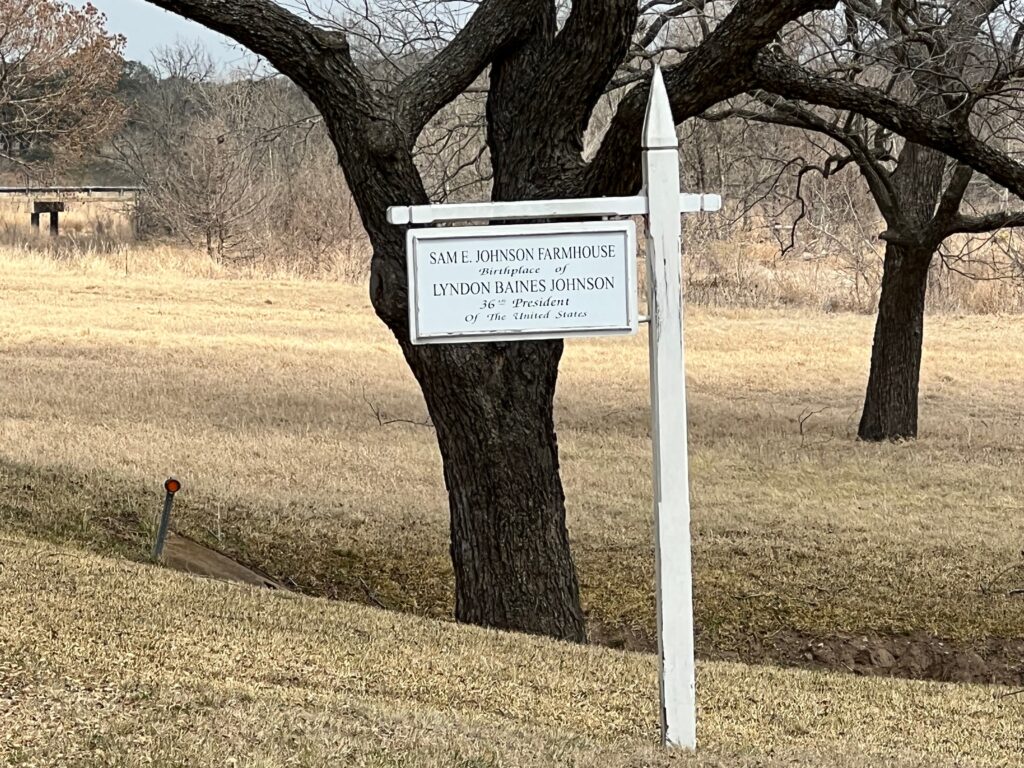
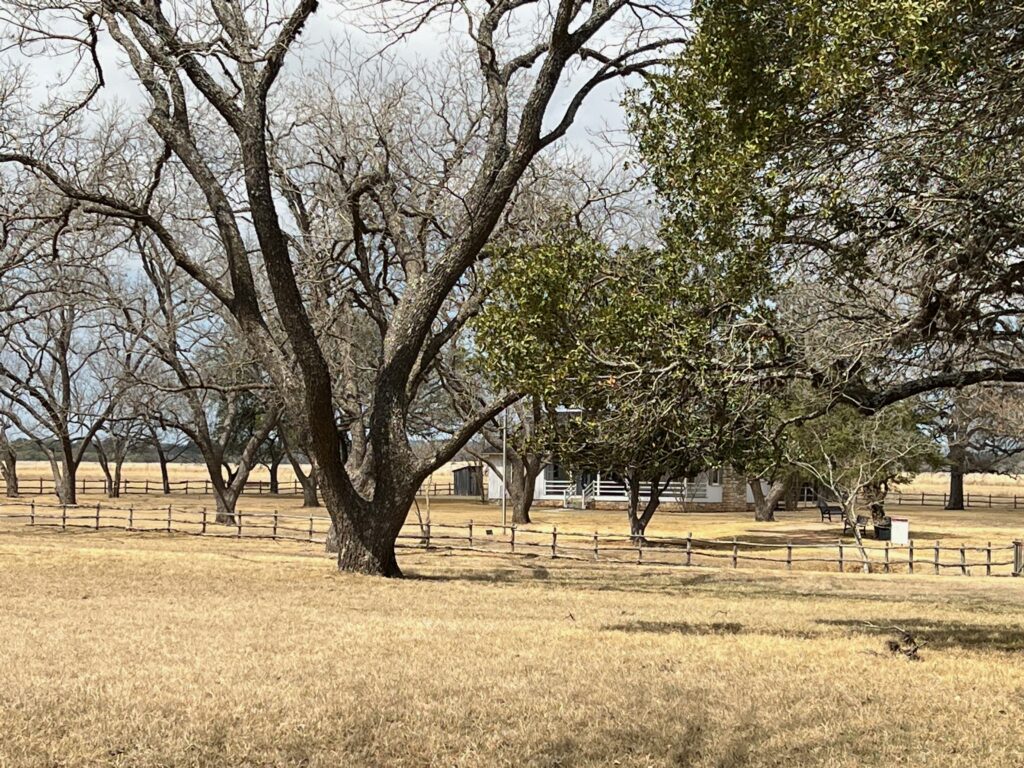
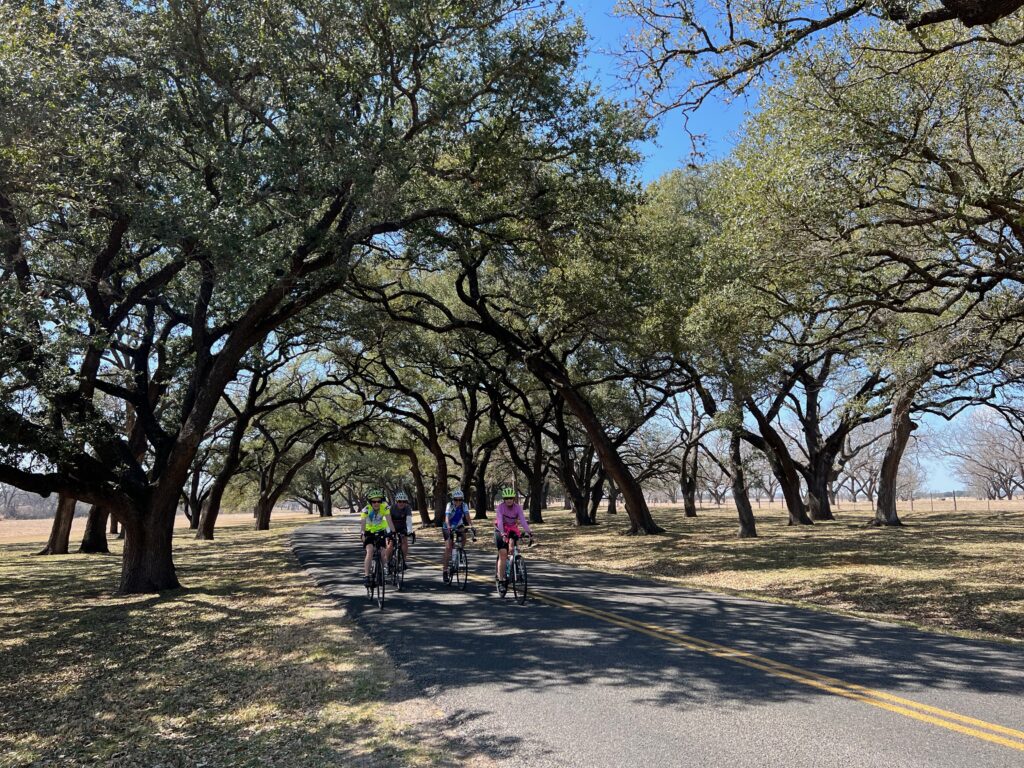
I was able to get several pictures of JoAnna, Allison, Howard, and Barbara riding in the shade of some thriving live oak trees at the park. When the trees are healthy, this is what they look like. We ended up doing two leisurely loops through the park that day.
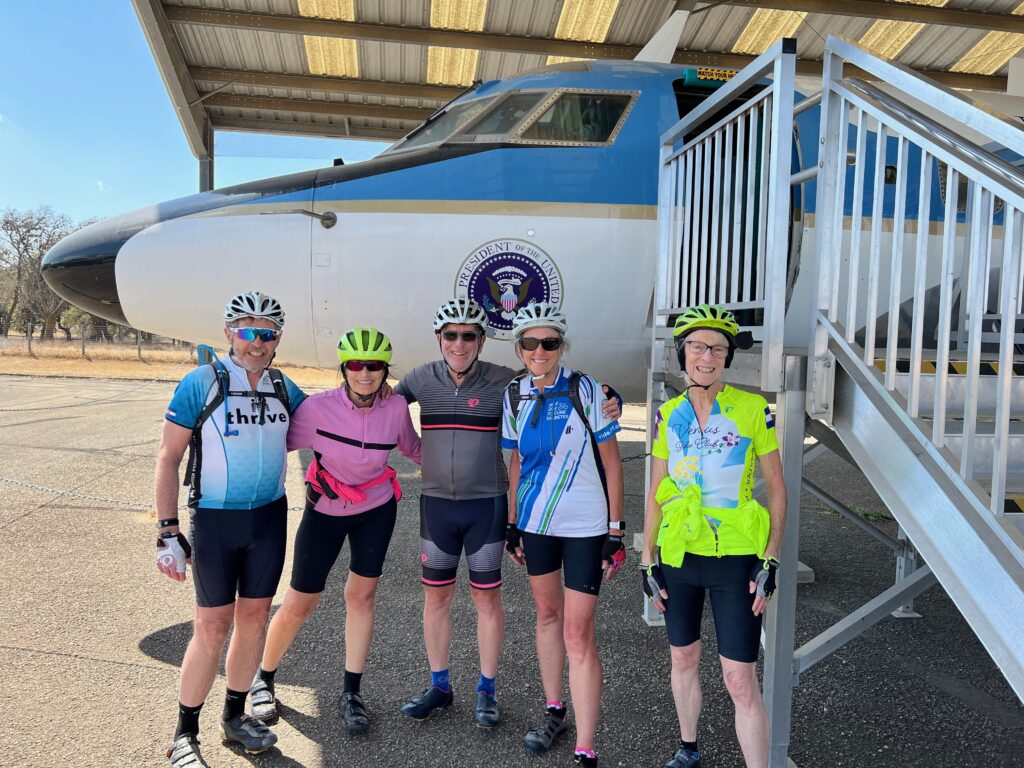
Johnson had a smaller version of Air Force One (I think it was called Air Force 1/2, or something like that.) that was able to land at his Texas White House. It is now kept there, where it used to land, for all to see. Here we are in our nerdy cycling togs posing in front of it.
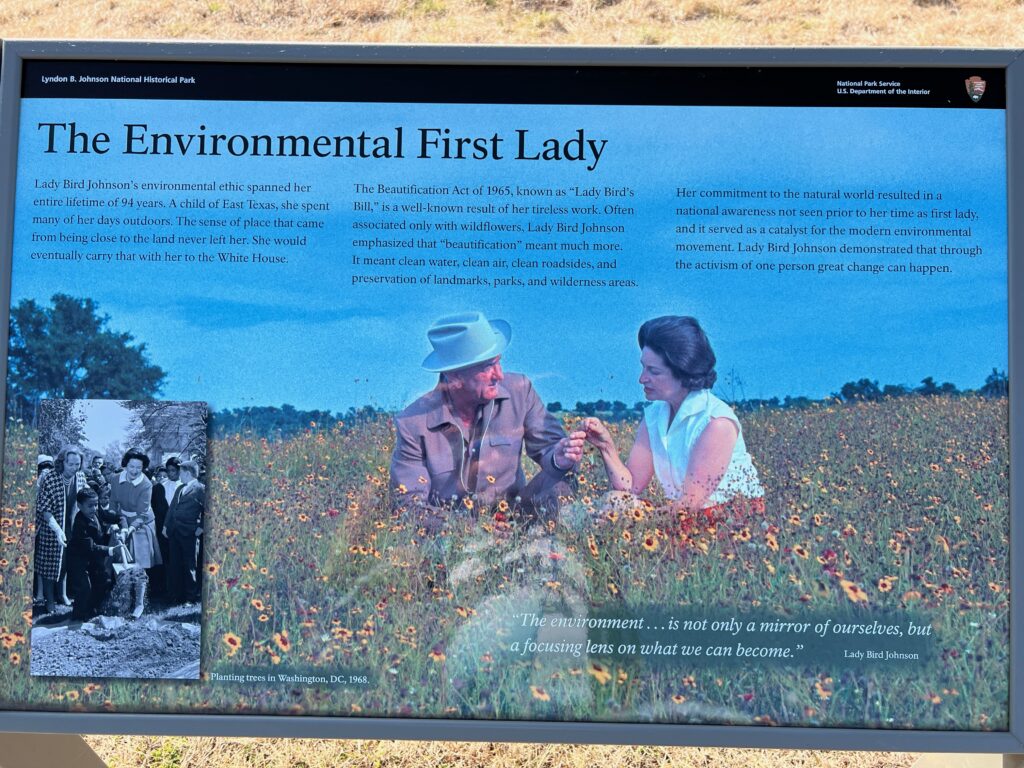
We all appreciated coming across a plaque that acknowledged Lady Bird as much as LBJ when it came to environmentalism. Riding through the blighted live oaks, and later on driving the stretch between Lubbock and Amarillo on my way home, seeing the sky filled with the brown dust of top soil blown into the air, I could not help but think of Texas as an environmental disaster. But I do remember how concerned many Americans were during Johnson’s administration about population growth, the economics of agriculture, the protection of natural coastlines, the conflict between development and preservation, air and water quality, etc. Fifty-five years later, only one of the five of us on this cycling trip drives an electric vehicle, and it’s not me.

This last picture is of us in front of Johnson’s Texas White House. As we were standing in front of this place we struck up a conversation with two women who were teachers from northeastern Texas, near Arkansas, on spring break. They took this picture for us, and we started talking about how poorly funded public education is in Texas. They felt strongly that Greg Abbott needed to be voted out of office, but did not come out and endorse Beto O’Rourke. Without mentioning names, they said they had no ideas for who should replace Abbott.
Albert Ice House and Dance Hall, the Cowboy Cantina
The LBJ Park is just outside of Stonewall, Texas, a town of 525 people. Dining options are limited, but we were hungry after doing two loops around the park, and no one felt like driving back to Fredericksburg for dinner. A Google search revealed that Albert’s Ice House and Dance Hall, with food provided by the Cowboy Cantina, was the best dining option within a wide radius of Stonewall. It was a six-mile drive from the LBJ ranch, and as we were speeding along across remote ranch land we began wondering if this was a place where we would feel welcome. When we pulled up we saw a food truck, a bar that looked looked like a horse stable, and a third building that was a cross between a small airplane hanger and a Quonset hut. There were a few tables set up on a deck adjacent to the bar, and a half dozen picnic tables under trees between the buildings and the parking lot. Suddenly I starting thinking this was going the be the most fun meal we would have the whole trip.
I was right. Even though the Cowboy Cantina only offered gourmet fries and burgers, the cheese fries with jalapeños were plenty to satisfy this pescatarian, and the Taylor-playing singer on the outdoor stage at the bar had a voice and a style that rivaled Jerry Jeff Walker.
Singer at Albert’s Cowboy Cantina
March 18th – A Day off in Boerne, Texas
I’m not sure who heard about Boerne (Bernie), but it was probably JoAnna. She was the one who did most of our online exploring. When it came to our day-to-day planning, I was passively along for the ride. But we all agreed that Thursday, March 18th was predicted to have high winds so it would be a good day to stay off the bikes and see a little more of the Hill Country.
Boerne is a tourist town of 16,000 people, 39 miles south of Fredericksburg, and 34 miles southeast of Kerrville, the site of he famous Kerrville Folk Festival (more on that later). Someone in our group recommended that we visit the Hill Country Mile and the Cibolo Nature Center, but first we needed to find a place that served good coffee. Allison found the Black Rifle Coffee Company through a Google search, so we decided to immerse ourselves in Texas firearms culture while enjoying our lattes and espressos. The coffee was as good as any you’d find in Seattle, Manhattan, or any other city concerned about gun violence.


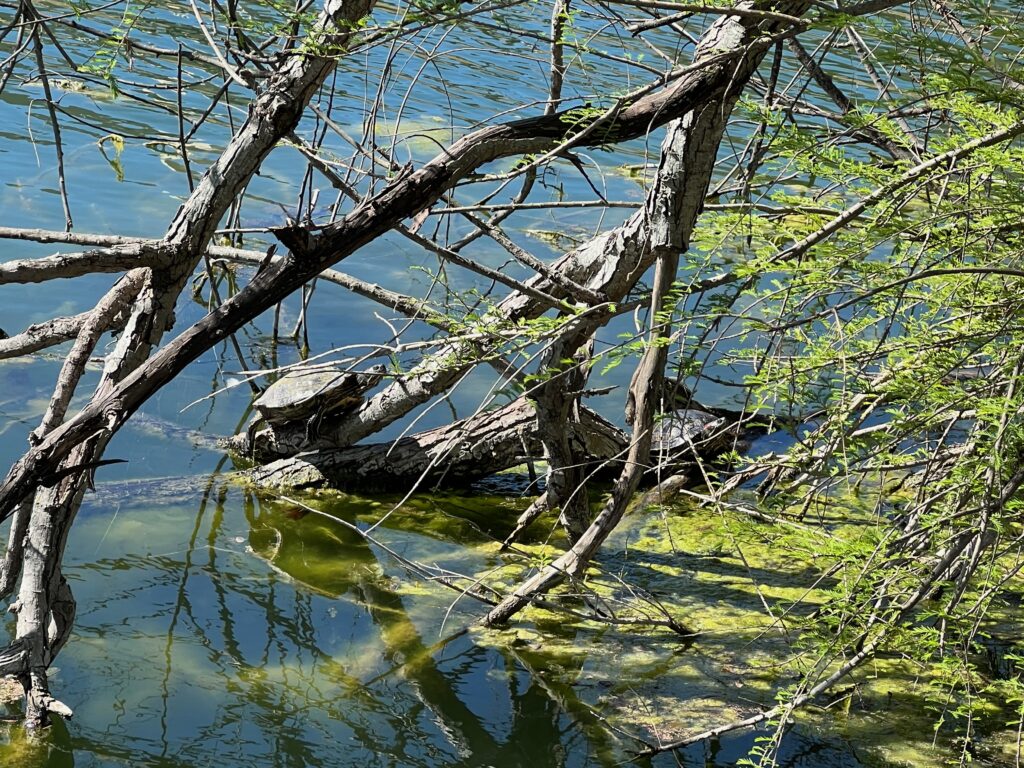
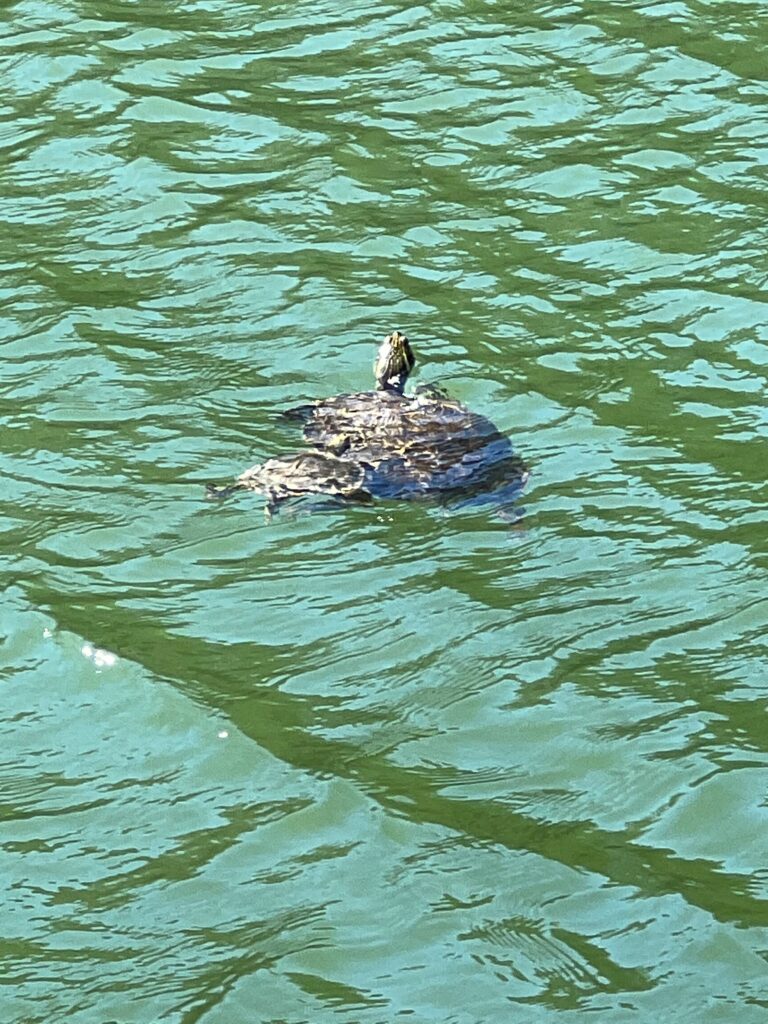
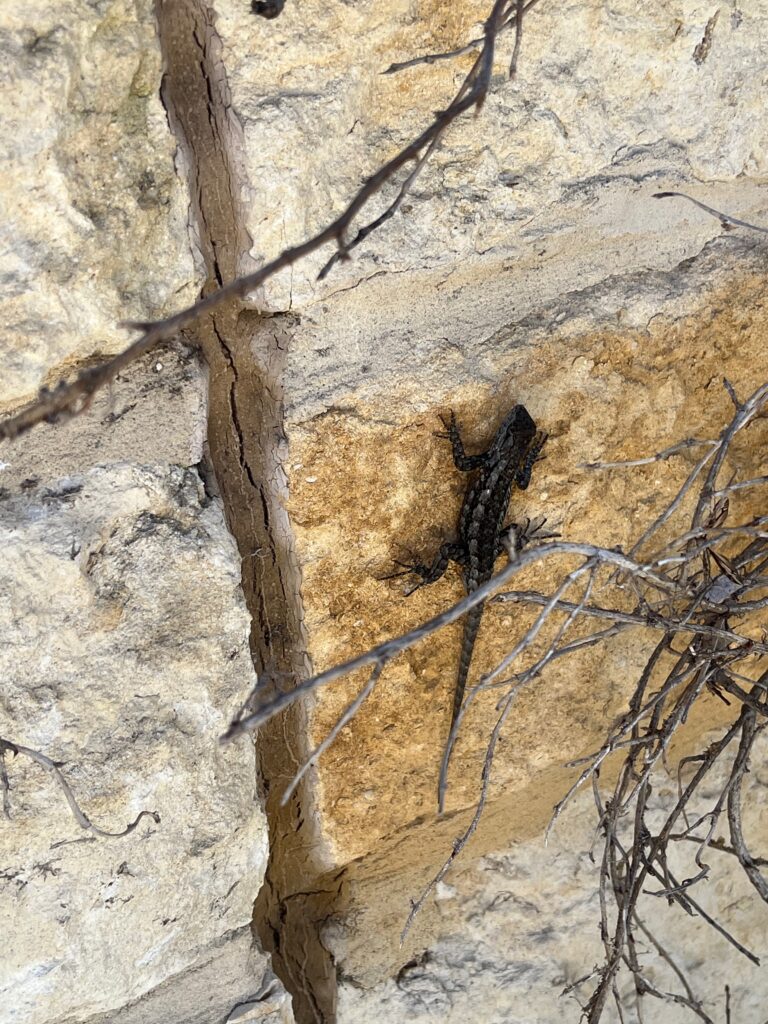
The pictures above are from the walk along a section of the Hill Country Mile that goes along the Cibolo Creek. Barbara told us that the bird is a domestic Muscovy Duck. There were lots of painted turtles on logs and swimming in the water, and we found a lizard clinging to the limestone wall.
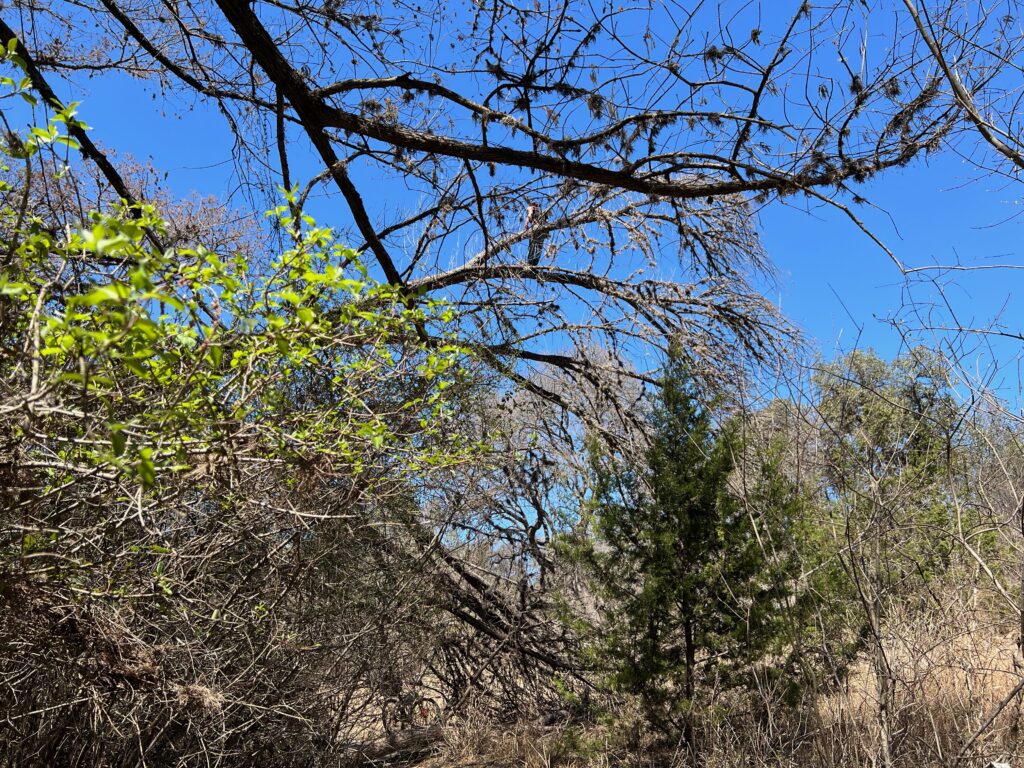

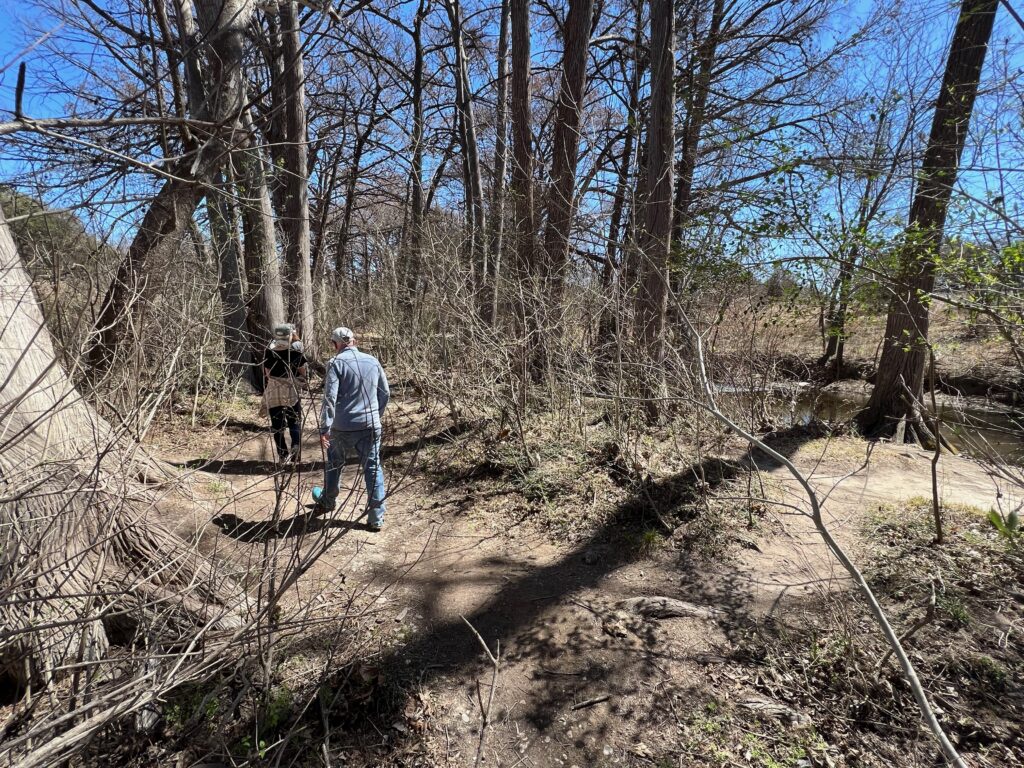

Later in the day we went out to the Cibolo Nature Center and walked along trails that bordered the creek. The guy high up in the trees was not part of our group.
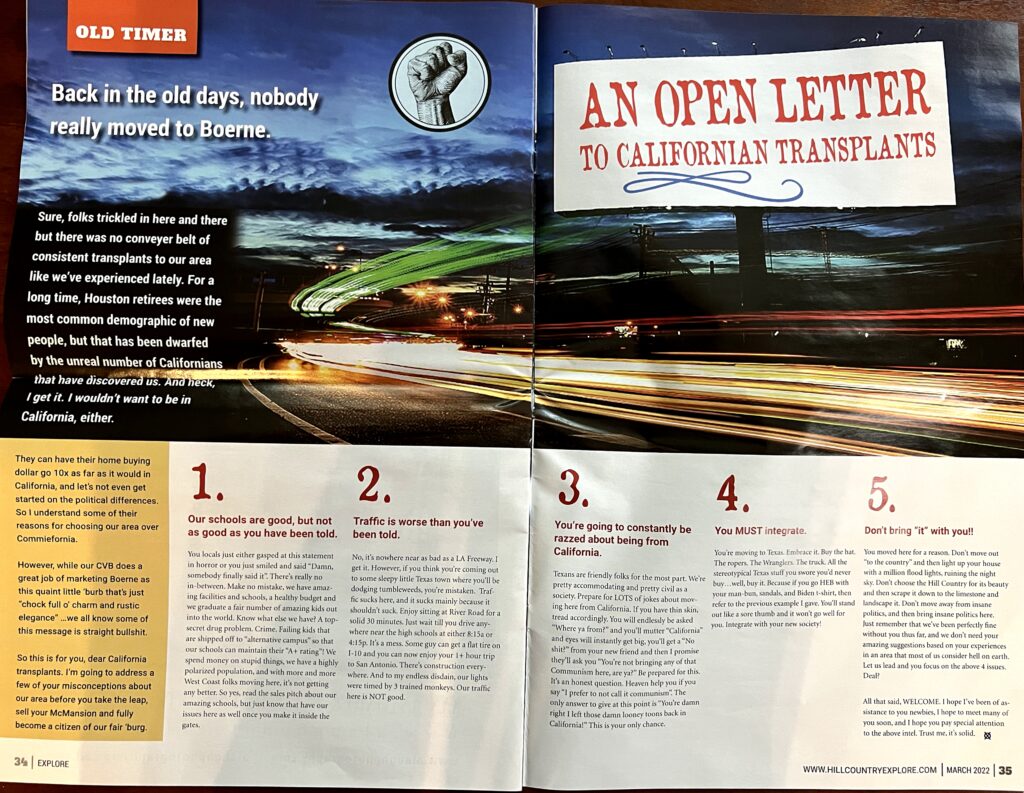
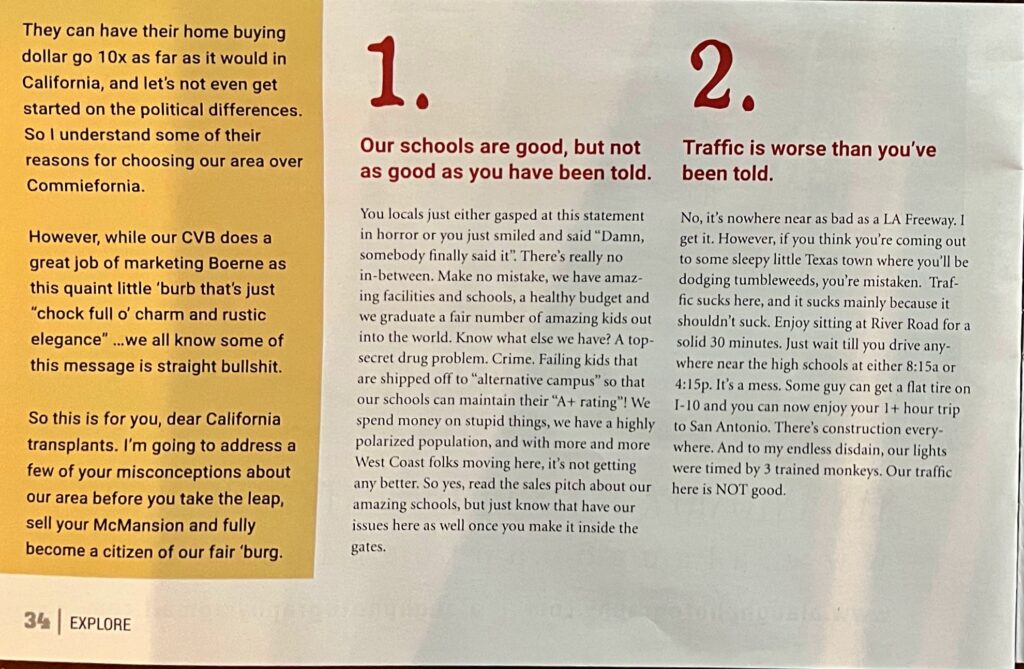
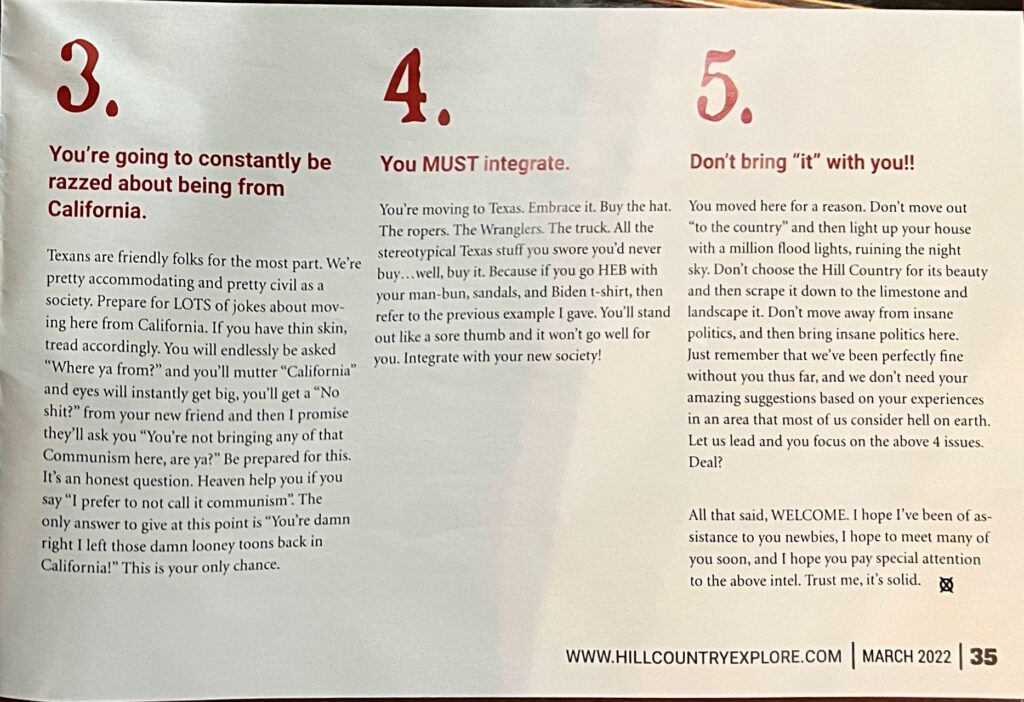
On one of our stops in Boerne we came across a publication called Explore Boerne, a local magazine aimed at tourists. Inside we found this clever little column that, upon first read, appeared to be a rant from a senior citizen native to the area who had been watching too much Tucker Carlson. But after a more careful read it became obvious that the piece was too well written to have been authored by anyone holding the views espoused in the column. We suspected it was a parody. JoAnna later called the editor of the magazine who confirmed our suspicions.
I only discovered in researching Boerne more recently that the town first started in connection with the Texas Hill Country Free Thinker Latin Settlements. The first Boerne settlers were members of a group called the Forty-Eighters, intellectual liberals and German ex-patriots who were abolitionists, believed in utopian ideals, and engaged in conversations about science, philosophy, literature, and music. They believed in basic human rights for all, and their values were quite different than the stereotypes we have of rural Texans today that we form when we listen to Ted Cruz, John Cornyn, and Greg Abbott.
Kerrville Folk Festival
I said I would say a little more about the Kerrville Folk Festival. the Wikipedia page is quite informative, so I will include a link here. We did not get to Kerrville, but I am excited to think that we were so close to the grounds where it is held. As someone who dabbles in songwriting myself, I see that there are many singer/songwriters I admire who have been winners and finalists at Kerrville. The list includes Nanci Griffith, Steve Earle, Tish Hinojosa, Lyle Lovett, Robert Earl Keen, John Gorka, James McMurtry, David Wilcox, and Slaid Cleaves.
In browsing their website I see that there have been a number of songwriters selected as finalists in the past several years from the Denver/Boulder area. Though I don’t know them personally, this list includes Spencer LaJoye, Andy Sydow, China Kent, Shanna in a Dress, Kyle Donovan, and Erinn Peet-Lukes.
March 19th – Willow City
We planned our longest ride for Saturday, March 19th, trusting the forecast that said the winds would be mild. We found a route on Ride with GPS that went out to Willow City that looked like it had a fair amount of climbing and would be a challenging distance. It would be the last ride for Allison and me, while Howard, JoAnna, and Barbara would stay in Fredericksburg for another day.
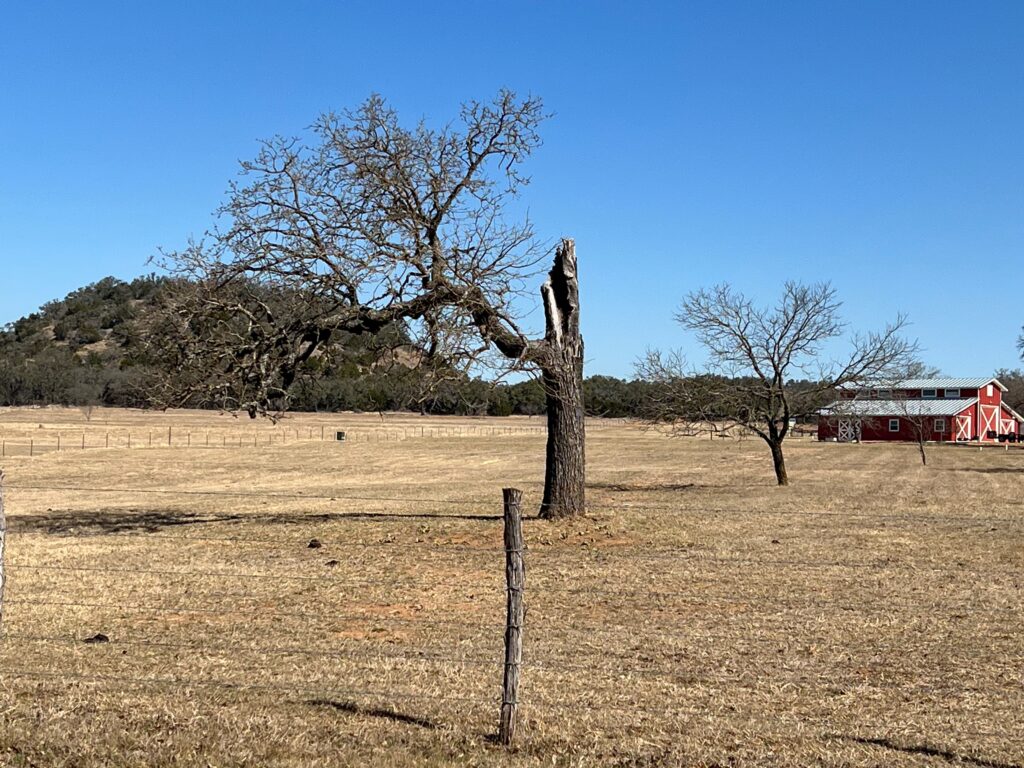
We saw very little in the way of civilization on our ride out to Willow City. The community itself consisted of a crossroad with a handful of buildings. A Google search revealed that it had a population of 75 people in the year 2000. I doubt that many people have settled there since then.
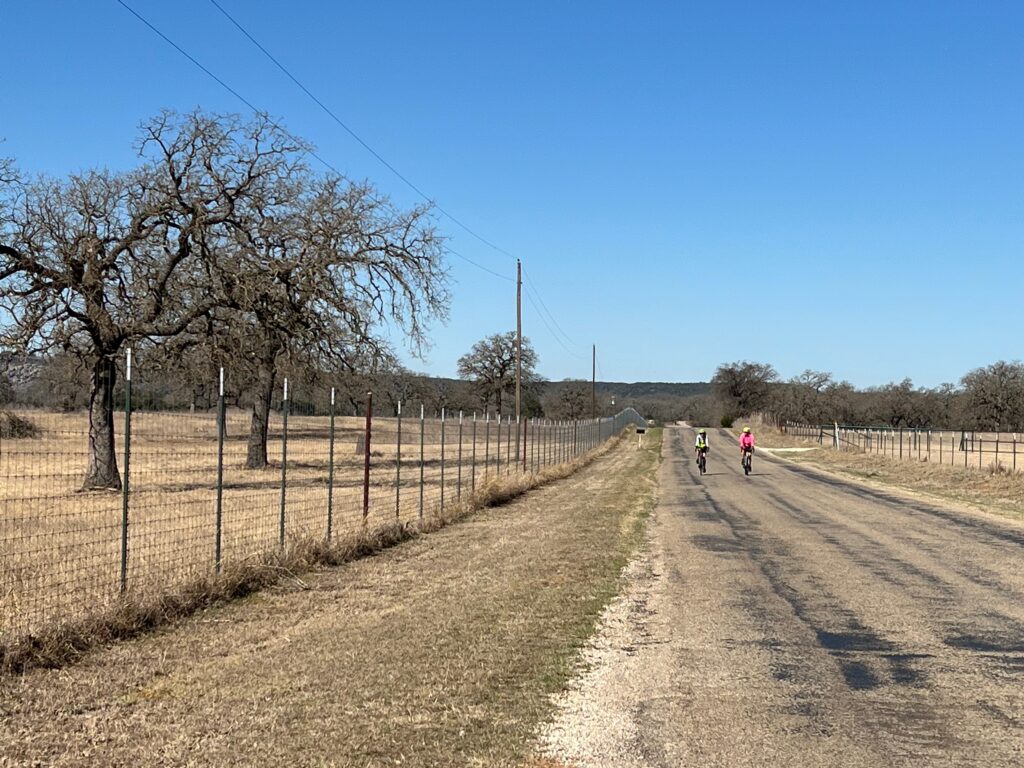
Here are JoAnna and Barbara approaching one of the few junctions we encountered on our ride.
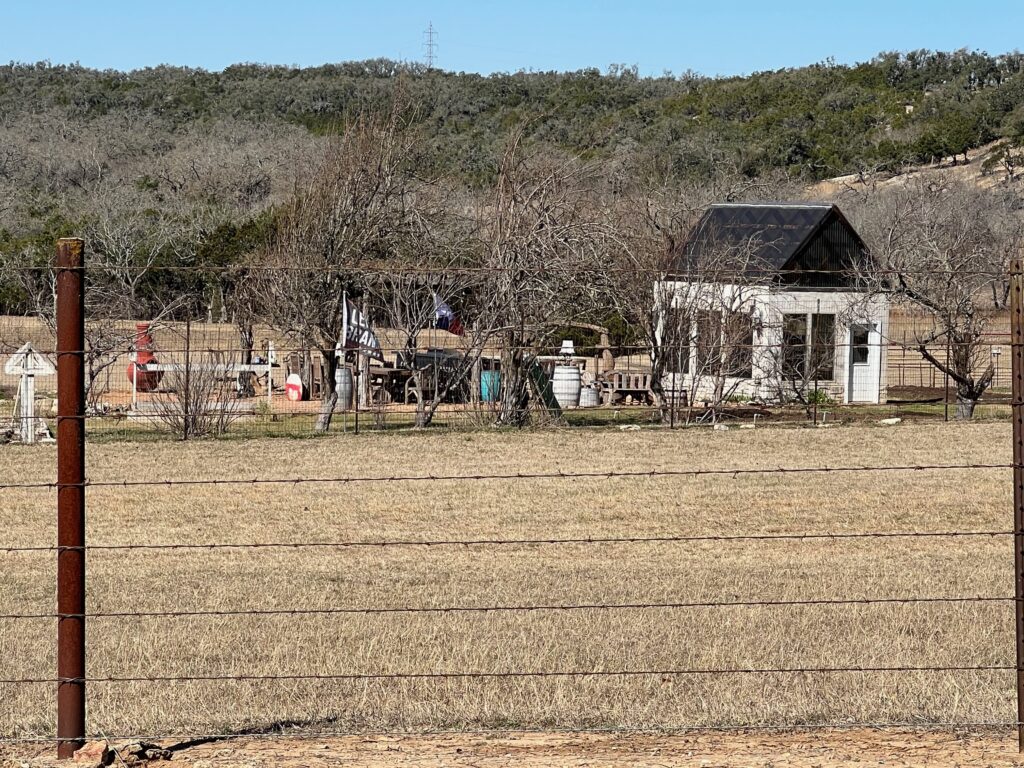
The resident of this modest estate was displaying a flag with the slogan, “Let’s Go, Brandon.” I tried to snap this picture as the flag was fully extended in the breeze but could never get the timing right. You can never know for sure what goes on in someone else’s mind, or what inspires one to put up a phrase that is code for a hateful curse aimed at our current president. Is this person grateful for the economic prosperity that he enjoyed under the previous administration? Does he share contempt for the same people that Trump does, and wants to feel empowered to express that contempt openly again? Perhaps by freely displaying his support for current right-wing politics he thinks there is a spot reserved for him in his imagined afterlife paradise. Or is he just plain taken by the cleverness of it all?
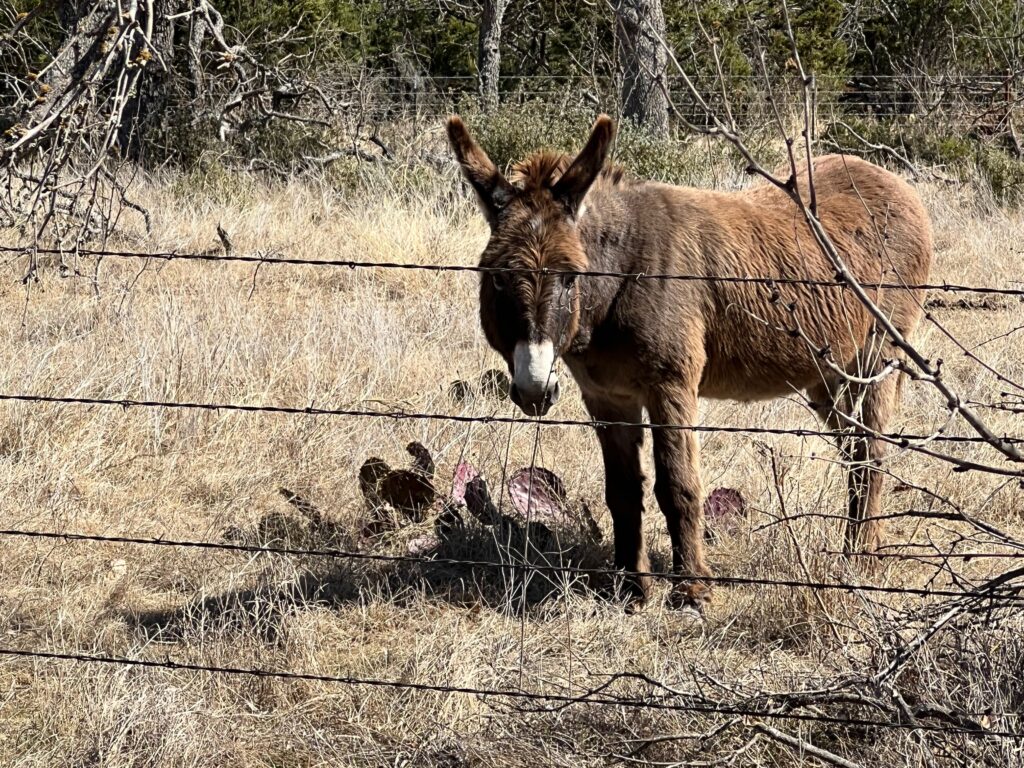
Was it a sign of a left-wing conspiracy that we saw donkeys on our ride but no elephants? Or was this creature just there to remind us of the wisdom of the resident living on the property in the previous photo?
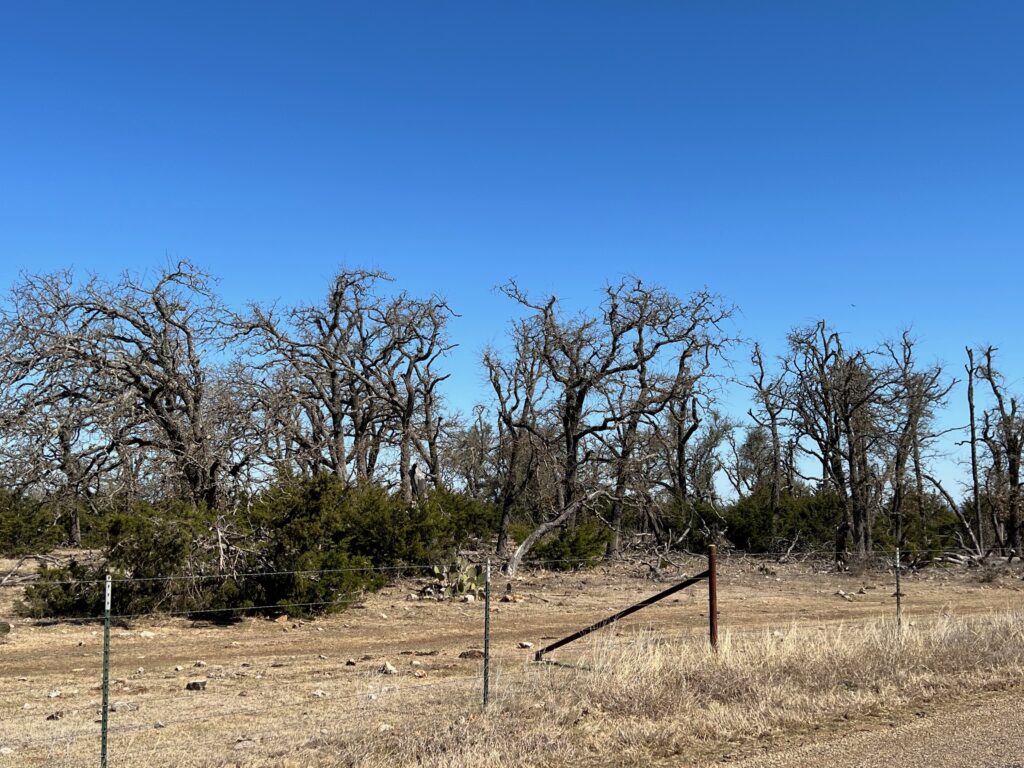
This was a sad stand of blighted live oak trees. In pictures that show ridge lines the trees higher up appear to be healthy. I wonder if the lower lying trees are more susceptible to the wilt?
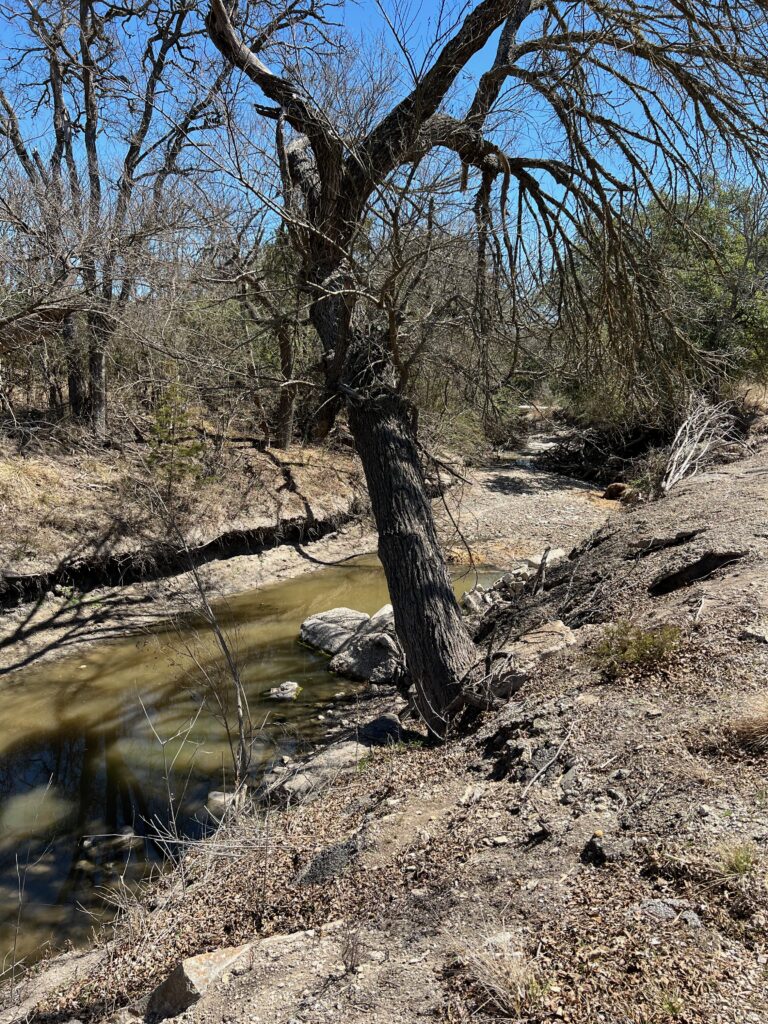
These trees along the creek are probably willows, and unlike live oaks, are without leaves during the winter. I assume these are healthy trees that just haven’t leafed out yet, being so early in the season. This was a beautiful little creek bed, but I wonder if it is drier than usual.
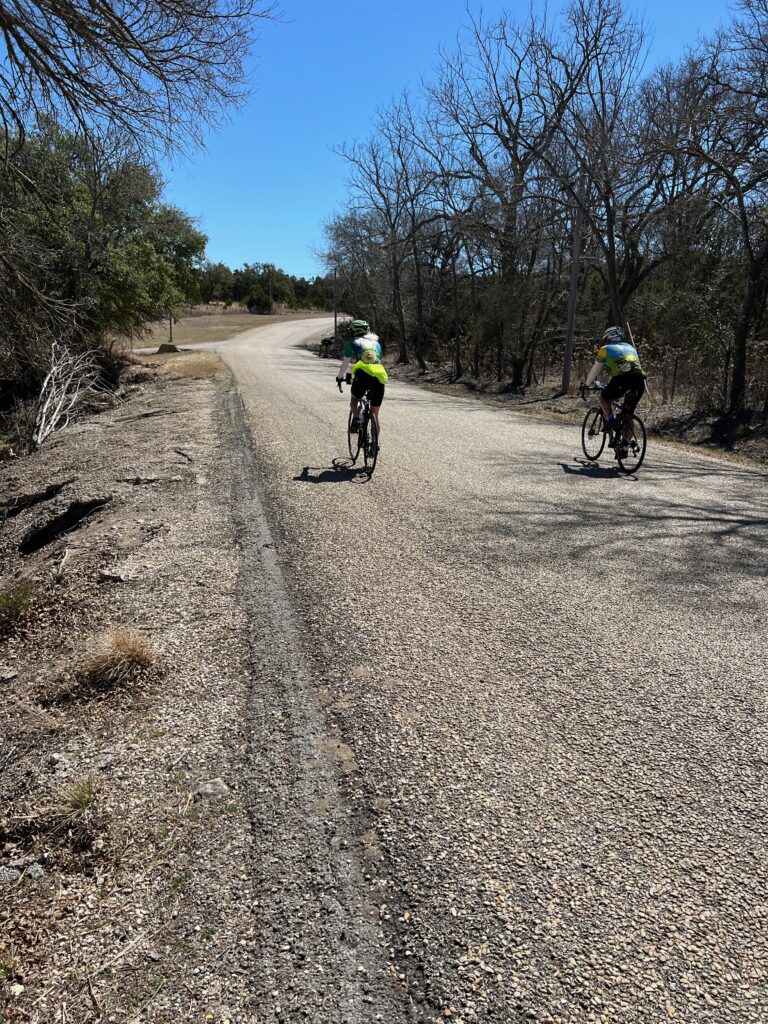
As I stopped to take a picture of the creek at the bottom of our descent Barbara and Howard came whizzing by.

And then came Allison and JoAnna.
The longest climb of the day took place between about the eighth and eleventh miles, followed by many ups and downs after that, but no more sustained climbs. I caught videos of Howard, Allison, JoAnna, and Barbara reaching the top of that first long climb, which we were glad to get out of the way early on.
Sunday, March 20th
I took off early the next morning for Denver, and I understand Allison had depart sometime in the middle of the night or very early in the morning as well. Howard, JoAnna and Barbara stayed on to ride another day. Howard was going to meet a friend and extend his Texas vacation by visiting Big Bend National Park. JoAnna and Barbara had a flight scheduled for Monday. I had planned to drive to Amarillo on Sunday, but with news of an incoming storm on Monday I decided to go all the way to Denver in a straight shot. It had been a good trip – not as scenic as South Dakota but it afforded a chance to see a part of the country I am glad I got to know. If I ever go back it will likely be for the Kerrville Folk Festival.